
6 Best Sailboat Depth Finders

Last Updated by
Daniel Wade
June 15, 2022
When sailing, a depth finder is a must-have accessory if you want to enjoy yourself without worrying about hitting the bottom while out there on the water.
And even though they're all made to serve the same purpose, they're not made the same. It's, therefore, important to go for a depth finder that can offer you real-time updates to ensure that you stay safe at all times.
When it comes to sailing, you'll enjoy it a lot more if you're able to know the depth of the water where you're sailing at. But when you go on the internet in search of the best sailboat depth finders, it's unfortunate that you'll come across fish finders instead.
Well, this may not be totally surprising given that they both use sonar. However, if you're more concerned about the depth of the water, especially if you don't want to ground your sailboat, then going for the best sailboat depth finder is the wise thing to do.
In addition to using the sonar system, today's sailboat depth finders are designed with a lot of innovative technology and built-in features such as GPS and Wi-Fi. This is to ensure that the devices are more robust and can offer real-time updates on the depth of water where you're sailing at.
More important, it will help keep you and your sailboat safe and prevent it from grounding just because you unknowingly sailed in shallow waters.
The importance of a depth finder for your sailing is so immense and that's why there are a lot of depth finders in the market that choosing the best sailboat depth finder can feel overwhelming.
So instead of spending hours on end scouring the internet trying to find the right model for your sailing adventures, we've made it a lot easier for you. Here's a list of the best sailboat depth finders to help you make the most of your sailing escapades.
Table of contents

The Basics of a Depth Finder
It's of great importance to know the depth of the water you are sailing on and this is why you should always have a proper depth finder when going out there on the water. You do not want to run aground and perhaps risk damaging your precious boat just because you unknowingly sailed in shallow waters.
With a depth finder, you'll know the exact depth of your ailing area and also get notified when you are within shallow areas. As such, depth finders generally offer readings in feet and meters but can also offer readings in fathoms. The alarm should alert you of shallow areas, which is great for your safety and the safety of your boat.
If you're wondering whether or not you can use a fish finder for measuring depth, we have to note that dedicated depth finders can offer more accurate data than fish finders.
How to Choose the Best Sailboat Depth Finder
While most depth finders will offer accurate depth readings, you should always think about the extra features that you need in a depth finder. It's of great importance to take your time and look at the price ranges and narrow down to what you can afford that's if you're on a budget.
In addition to the features, you can also consider the warranty in place, the required features, the technology used, and ease of installation and use. You certainly do not want a device that's pretty difficult to mount on your boat or a device whose display will be hard to read in the sun or in low light conditions.
Other things such as portability, screen sizes, mountable options should be considered when choosing the best depth finder for you. With that in mind, we can tell you for sure that you'll be making a really solid choice if you choose any depth finder on this list. You should also go for a depth finder that can work perfectly even when the boat is moving at high speeds.
Here are the 6 best sailboat depth
1. HawkEye DepthTrax 1
For many sailors, depths that are greater than 200 feet aren't a concern to them since their sailboats aren't going to run aground in such depths. Instead, their main concern is about the accuracy of the readings and this is exactly what the HawkEye DepthTrax 1B brings to the table. This depth finder is engineered to provide precise depth readings from 2.5 feet to 200 feet. The best part of using this depth finder is that it will offer these exact readings as speeds of over 60 mph!
So even if you're moving so fast, it has a warning system that will ensure that you do not run your boat aground as it will warn you accordingly as you approach shallow areas. You can also adjust this device to offer the best depth readings for individual boats. All you have to do is program the keel offset function and you'll be good to go.
Its glare-free display makes it user-friendly as you can perfectly see the reading even in bright lights. Similarly, it's designed with a backlight that makes it a lot easier to read the display even in low light conditions. It also comes with a glue-in hull transducer and transom mount to make using it a lot easier.
- Offers accurate depth readings even when in high speed
- It's very easy to use
- The large display makes it user-friendly
- It comes with 2 alarms that will let you know when you reach the depth you've set
- It's durable and waterproof
- The reading may not be that accurate if there's an object under the water surface
2. Humminbird 407860-1 HDR650 Digital depth Gauge
As a well-known maker of some of the best fish finders, it's totally not surprising that the Hummin brands feature a number of times on this list. Even though the Humminbird 407860-1 HDR650 doesn't double up as a fish finder, it's a capable digital depth finder that provides instant readings even when the sailboat is on the move.
It's designed with a 200 kHz transom mount transducer as well as installation hardware to make it very easy to mount and use on the sailboat. Its color is so attractive and is designed in such a way that it complements the rest of this depth finder. The 1.25-inch display comes with a backlit that makes it's a lot easier to read and use even in low light conditions. The fact that it is digital enables it to show depth in various measurements such as feet, meters, and even fathoms! It also has an alarm that will warn you when your boat is about to hit shallow waters.
- The display is simple, clean, and easy to read
- It's easy to mount on the boat
- It offers very accurate depth readings
- The shallow depths alarm keeps you alert when your boat is about to hit shallow depths
- It's waterproof and fairly durable
- It's affordable
- The transducer cord is short and may not perfectly reach the device
3. HawkEye D10DX In-Dash Depth Sounder
If you're looking for a depth finder that offers more than just depth readings, the HawkEye D10DX can be an ideal choice. In addition to offering accurate depth readings, this device can also measure the water and air temperatures. It also gives you the option of choosing between a thru-hull transducer and a transom-mounted transducer.
In terms of readings, this device is designed with a very large display that makes it easy to use and read even at night. The anti-glare feature of the display makes it superb in sunny conditions while the backlit feature makes it excellent in low light conditions. This device will never let you down even when you're sailing at a speed of 30 mph.
This device is also designed with special programming to mitigate any false reading that might occur. More importantly, it comes with a visual alarm that can alert you if you're about to hit shallow waters. In terms of water and air temperature, these features are great if you want to know the condition under which you're sailing.
This device is easy to install and comes with marine-standard electrical connectors to ensure that you're safe at all times.
- It's easy to install and use
- It offers accurate depth readings
- It offers additional water and air temperature readings
- The alarm can alert you if you're about to hit shallow waters
- It's waterproof and durable
- You can choose between two transducers
- The readings can be inaccurate in dirty waters or muddy bottoms
4. Lowrance LST 3800
This superb depth finder is designed with an excellent transom mount transducer that provides accurate readings in up to 700 feet! It will also never disappoint you if your boat is going at a speed of about 50 mph. That's not all; this device can also provide temperature readings when out there on the water.
Its high contrast dot matrix screen comes with a backlit that makes it a lot easy to read in both low light conditions and in the glare of a hot sunny day. This device is designed with three main display pages that provide readings for depth, temperature, and dual display. The fact that you can control the displays with the three-button keypad makes it user-friendly.
This device also comes with an alarm system to notify you if your boat is almost hitting shallow waters. The readings can be offered in both meters and feet in terms of depth and Celsius and Fahrenheit in terms of temperature.
- It offers one of the best displays
- It's easy to use
- Offers both depth and temperature readings
- It's easy to mount
- Offers very accurate readings
- Not ideal for people whose primary concerns are depth readings only
5. Humminbird 409670-1 PiranhaMax 197C Color Fish Finder
Although it's a fish finder, this device can also be used as a super depth finder thanks to its multiple features such as a very large display that offers very accurate info that's easy to read both during the day and at night.
The best thing about this device is that it will offer accurate depth reading while showing the water temperatures as well as images of various objects and contours under the water. Thanks to its dual frequencies and down imaging, you'll get the idea of what's happening under your boat. Its 1600 watts of power is so powerful that you don't have to worry about its battery running out while you're out there on the water.
And like most depth finders, this device is designed with an intuitive alarm system that may give you a heads up as you approach shallow waters. This is a very versatile device that will serve you on your fishing , sailing, or diving escapades.
- Very versatile
- Installation and ease of use are top-notch
- The display is very clear both at night and during the day
- The alarm system will alert you of shallow depths
- The fact that it comes with several features can be overwhelming to those who need a simple depth finder
6. Garmin Echo 551dv Worldwide with Transducer
This is an excellent depth finder that can also work as a basic fish finder. With a power peak of 4,000 watts, this device can easily offer accurate readings up to 2,300 feet, which is pretty outstanding. Designed with built-in HD-ID sonar, this device gives the option of either working with a transducer or even without it.
Thanks to its very large 5-inch QVGA colored display, the info is easy to read. This display can offer accurate readings of not just the depth but also the contours of the bottom as well as whatever object that's under the water. If you're interested in catching some fish, you can choose the fish icon to show the fish but you can choose to leave this option if you're interested in fishing so that it doesn't clutter the screen.
The alarm system is crucial in alerting you as you approach shallow depths. This is of great importance in keeping you safe and ensuring that your boat doesn't run aground. You can also look at the history to see the depths and details of where you have been before.
- Offers accurate depth readings
- Can give you the option of finding fish
- The alarm system can alert you as you approach shallow depths
- It's easy to install and use
- It also offers temperature readings
- You can set alarms at the depths you want
- It offers too much information and not ideal if you want a simplistic depth finder
To this end, depth finders can be a game-changer even if you're a novice sailor. The initial investment might be big but you'll certainly come to appreciate the benefits that these devices offer. So if you've been looking for the best sailboat depth finder, choose any of the above-described models and you'll be good to go. If anything, you'll make more out of your sailing experience.
Happy sailing!
Related Articles
I've personally had thousands of questions about sailing and sailboats over the years. As I learn and experience sailing, and the community, I share the answers that work and make sense to me, here on Life of Sailing.
by this author
Sailboat Upgrades

Most Recent

What Does "Sailing By The Lee" Mean?
October 3, 2023

The Best Sailing Schools And Programs: Reviews & Ratings
September 26, 2023
Important Legal Info
Lifeofsailing.com is a participant in the Amazon Services LLC Associates Program, an affiliate advertising program designed to provide a means for sites to earn advertising fees by advertising and linking to Amazon. This site also participates in other affiliate programs and is compensated for referring traffic and business to these companies.
Similar Posts

How To Choose The Right Sailing Instructor
August 16, 2023

Cost To Sail Around The World
May 16, 2023

Small Sailboat Sizes: A Complete Guide
October 30, 2022
Popular Posts

Best Liveaboard Catamaran Sailboats
December 28, 2023

Can a Novice Sail Around the World?
Elizabeth O'Malley

4 Best Electric Outboard Motors

How Long Did It Take The Vikings To Sail To England?

10 Best Sailboat Brands (And Why)
December 20, 2023

7 Best Places To Liveaboard A Sailboat
Get the best sailing content.
Top Rated Posts
Lifeofsailing.com is a participant in the Amazon Services LLC Associates Program, an affiliate advertising program designed to provide a means for sites to earn advertising fees by advertising and linking to Amazon. This site also participates in other affiliate programs and is compensated for referring traffic and business to these companies. (866) 342-SAIL
© 2024 Life of Sailing Email: [email protected] Address: 11816 Inwood Rd #3024 Dallas, TX 75244 Disclaimer Privacy Policy

- Forums New posts Unanswered threads Register Top Posts Email
- What's new New posts New Posts (legacy) Latest activity New media
- Media New media New comments
- Boat Info Downloads Weekly Quiz Topic FAQ 10000boatnames.com
- Classifieds Sell Your Boat Used Gear for Sale
- Parts General Marine Parts Hunter Beneteau Catalina MacGregor Oday
- Help Terms of Use Monday Mail Subscribe Monday Mail Unsubscribe
transducer location
- Thread starter tgrayson
- Start date Dec 29, 2019
- Forums for All Owners
- Ask All Sailors
where would the best place to install a transducer be on a mac venture 17 swing keel
What kind of transducer? Speed or Depth? or a Single SDT transducer. In general transducers should be mounted in an area where the water is not turbulent. This would eliminate most areas along the keel/centerboard, off the transom and behind the keel/CB. That leaves the area in front of the keel. for a variety of reasons, the transducer should be mounted as close to the centerline as possible and pointing directly down.
would like to put an in hull transducer for a depth finder,in front of the keel sounds good,thanks
tgrayson said: would like to put an in hull transducer for a depth finder,in front of the keel sounds good,thanks Click to expand
Ralph Johnstone
Depth transducer.
V-berth I installed one on a Mac v22 once. I pushed it into a wad of plumbers putty. it was meant as a temp to see if the location worked but two years later I still had not replaced the putty with something more permanent
good idea , I'll give it a try
Project_Mayhem
rgranger said: V-berth I installed one on a Mac v22 once. I pushed it into a wad of plumbers putty. it was meant as a temp to see if the location worked but two years later I still had not replaced the putty with something more permanent Click to expand
Project_Mayhem said: My boat came with an old speed sensor in the bow. After launch I found a small trickle of water from it. The water pressure prevented most of the common marine sealants and putties from working. Not wanting to pay to have the boat forklifted in and out of the water I tried plumber's putty. Little by little I was able to reduce the flow. It was able to eliminate it for a few months. The bow was a bit wet at the end of the season indicating that the plumbers putty was allowing water through. Regardless, It saved me $200, I now carry two tubes on-board and I know the stuff could get me out of a jam someday. One more pre-launch project to take care of in the spring... The Norcross/Hawkeye transducer that I bought has a slanted mounting surface to help keep the transducer level despite the angle of the hull. Click to expand
- This site uses cookies to help personalise content, tailor your experience and to keep you logged in if you register. By continuing to use this site, you are consenting to our use of cookies. Accept Learn more…

Please verify you are a human
Access to this page has been denied because we believe you are using automation tools to browse the website.
This may happen as a result of the following:
- Javascript is disabled or blocked by an extension (ad blockers for example)
- Your browser does not support cookies
Please make sure that Javascript and cookies are enabled on your browser and that you are not blocking them from loading.
Reference ID: afed3770-e5eb-11ee-ae70-f35abf1264c5
Powered by PerimeterX , Inc.

Service Locator
- Angler Endorsement
- Boat Towing Coverage
- Mechanical Breakdown
- Insurance Requirements in Mexico
- Agreed Hull Value
- Actual Cash Value
- Liability Only
- Insurance Payment Options
- Claims Information
- Towing Service Agreement
- Membership Plans
- Boat Show Tickets
- BoatUS Boats For Sale
- Membership Payment Options
- Consumer Affairs
- Boat Documentation Requirements
- Installation Instructions
- Shipping & Handling Information
- Contact Boat Lettering
- End User Agreement
- Frequently Asked Questions
- Vessel Documentation
- BoatUS Foundation
- Government Affairs
- Powercruisers
- Buying & Selling Advice
- Maintenance
- Tow Vehicles
- Make & Create
- Makeovers & Refitting
- Accessories
- Electronics
- Skills, Tips, Tools
- Spring Preparation
- Winterization
- Boaters’ Rights
- Environment & Clean Water
- Boat Safety
- Navigational Hazards
- Personal Safety
- Batteries & Onboard Power
- Motors, Engines, Propulsion
- Best Day on the Water
- Books & Movies
- Communication & Etiquette
- Contests & Sweepstakes
- Colleges & Tech Schools
- Food, Drink, Entertainment
- New To Boating
- Travel & Destinations
- Watersports
- Anchors & Anchoring
- Boat Handling
Selecting a Transducer
Advertisement
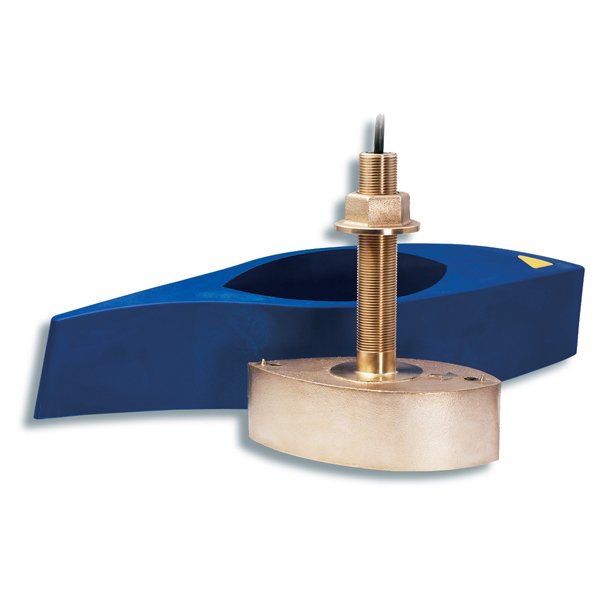
As the technology of sonar (an acronym for Sound Navigation and Ranging) has developed, prices have dropped dramatically at the same time that choices have widened. What once was a simple electronic device meant to determine the water's depth now has numerous capabilities to find fish, scan the bottom for obstructions, or create underwater maps.
Whether it's a simple portable fishfinder or a commercial mapping system weighing several tons, all sonar devices operate on the same principles using two parts: a transducer and a processor/display. The transducer is both a sender and receiver. It is placed in the water, or in a medium adjacent to the water, and emits an acoustic signal with a characteristic waveform. This signal passes through the water at a known rate of speed and is reflected off any object with a density different than water. When part of the acoustic signal strikes an object, it is reflected back to the transducer, which receives it and sends it to the processor.
The processor/display is a group of electronic circuits that interprets the signals received by the transducer. It will have some mechanism to display the results, ranging from a flashing light to color LCD graphic maps. Dedicated units often have some controls for signal gain or for other features. Some scanning models may even use a laptop computer as the processor and display.
Finding the proper depth sounder or fish finder to meet your needs requires a choice between numerous brands and models. Many of us have a tendency to solely concentrate on the features or appearance of the processor/display unit, neglecting the transducer altogether. This mistake can lead you to the wrong choice.
Transducer Frequency
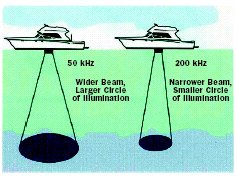
Transducers for recreational and light commercial boats usually operate on frequencies between about 25 and 400 KHz, with 50 and 200 KHz being the two most common. As with most radio or radar transmissions, lower frequencies generally have greater penetrating power while higher frequencies offer higher resolution or detail. A low frequency around 50 KHz is excellent for displaying a wide area of the bottom, especially if the water is deep, while a higher frequency shows more bottom detail in shallow water, a very useful trait for fishfinders and recorders. A depth sounder signal that reads up to 400' in fresh water may lose as much as half of its penetrating power in saltwater, so lower frequencies may be favored for saltwater use.
Many fishfinders have dual-frequency transducers, with 50/200 KHz combinations being the most common. Since the body of a fish is mostly water, the depth finder signals don't bounce directly off their bodies — it is the air in fishes' gills and air bladder that create the target. With dual frequencies, the low frequency can search a wide area of deep water for targets, showing schools of fish as wide patches on the screen. The higher frequency offers more detail of objects directly below the boat, showing better bottom formations, bottom-feeding fish, and schools of baitfish, especially in shallower waters.
There is wide variety in dual-frequency and multiple frequency models. Some have the ability to switch back and forth between two frequencies, while others offer two screens to view simultaneously. A few even have the ability to detect their own acoustic signals when a large number of boats fishing nearby with similar units create "crosstalk and other interference". The transducers of some high-end scanning sonars have multiple elements within their housings, allowing them to "see" in front of the boat or out to the sides.
Transducer Beam Width
A second important feature when selecting a depth finder transducer is the width of the beam (also known as cone angle) it was designed to emit. Transducers with a wide beam width of up to 50° will "see" around their location at a wide section of the bottom. As the amount of area is increased, the bottom resolution is decreased, so a wide beam is fine for searching for fish in the water column but not detecting bottom details like breaks, shallow holes or small contours.
A narrow beam of 10-15°, on the other hand, concentrates its energy on a section right below the boat. When looking for individual fish or bottom structure in shallow water (say under 100-200'), a narrow-beamed transducer should be the first choice. Note that there is a certain amount of correlation between a transducer's frequency and its beam width. As a general rule, lower frequency and a wider beam angle tend to go together while higher frequency and narrower beam width are usually companions. This makes sense, as the latter makes a great depth sounder while the former is an obvious choice as a fishfinder.
Output Power
Output power is quoted in watts just as any transmitter or audio receiver. Here, however, the ratings have little meaning and more power is not always better. Too much power in shallow water is as ineffective as too little power in deep water. Generally speaking, units in the 100-200 watt range are sufficient for shallow water use and units up to 1,000 watts and more may be necessary to probe deep canyons and drop-offs. Using a transducer from a 100-watt unit on a 1,000-watt unit is also not a good idea as the excessive energy from the more powerful fishfinder will soon destroy the crystals within the small transducer.
Transducer Materials
In the distant past, the working portion of all transducers was captured in a traditional bronze housing with a long, narrow stem and a curious aerodynamic shape. Today, many transducers are contained in space age strong plastic housings. These tough new materials have great advantages over bronze in reducing corrosion and electrolysis, and are designed to stand up to the abuse of long-term immersion in seawater.
Transducer Mounting and Style
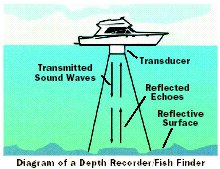
Transducers may be installed through the hull, in water- or oil-filled boxes inside certain hulls, attached to the inside of some fiberglass boats, or mounted on the transom. The only requirement is that no air space or high-density material blocks the transducer's stream of acoustic pulses. Because of this flexibility in mounting, several styles of transducers are manufactured, assuring easy installation on all types of boats.
Long-stemmed bronze transducers are still best when mounting through the hull on a boat with a very deep "V" or high deadrise angle where fairing blocks must be used to keep the transducer close to vertical.
Low-profile plastic transducers with a mushroom head are easiest to mount through the hull on a boat with a flat surface and little "V" shape.
A few low-profile through-hull models have a hollow plastic housing and a removable inner transducer. These are ideal for trailerable boats where the transducer might be damaged in the launching process.
Flush-mount transducers are ideal for depth sounders on racing sailboats and other applications where a fair hull is important. These sometimes require a special countersinking tool for proper installation.
Transom-mount transducers are usually flat on their leading edge, with an adjustable bracket or pivoting hardware to attach to the boat's stern below the waterline. When installing a transom-mount transducer, make certain it is mounted in an area of the transom with the least amount of disturbed water. It is not uncommon to find the ability of your transom mount transducer to show clear images is drastically reduced as the speed of the boat increases. Most often a small "adjustment" of the tilt or depth of the transducer can greatly improve its performance at high speed. On some vessels however, you may need to experiment by placing the transducer at different spots on the transom to obtain the optimum results.
Some transducers are specifically made to shoot through the hull. These are generally more accurate than standard transducers used in that manner.
Related Articles
The truth about ceramic coatings for boats.
Our editor investigates the marketing claims of consumer-grade ceramic coatings.
Fine-Tune Your Side Scan Fishfinder
Take your side-scanning fishfinder off auto mode, and you’ll be spotting your prey from afar in no time
DIY Boat Foam Decking
Closed-cell foam flooring helps make boating more comfortable. Here’s how to install it on your vessel
Click to explore related articles
BoatUS Editors
Contributor, BoatUS Magazine
Award-winning BoatUS Magazine is the official publication of Boat Owners Association of The United States. The magazine provides boating skills, DIY maintenance, safety, news and more from top experts.
BoatUS Magazine Is A Benefit Of BoatUS Membership
Membership Benefits Include:
Subscription to the print version of BoatUS Magazine
4% back on purchases from West Marine stores or online at WestMarine.com
Discounts on fuel, transient slips, repairs and more at over 1,200 businesses
Deals on cruises, charters, car rentals, hotel stays and more…
All for only $25/year!
We use cookies to enhance your visit to our website and to improve your experience. By continuing to use our website, you’re agreeing to our cookie policy.
It looks like you are using an outdated browser. Please consider upgrading your browser to improve your experience and security.
- Subscribe/Login
- Striper Cup
Pick the Right Transducer for Your Boat
A fishfinder is nothing without the right transducer, so select the best one for your boat – and your fishing.

What’s the right transducer for my boat?
As fish-finding technology has advanced, the number of decisions fishermen must make when setting up marine electronics has multiplied. However, consider these choices a blessing – they represent an opportunity to create a specialized system that best fits your fishing needs.
Transducers are the eyes (or more accurately, the ears) of your fishfinder. They send energy waves out into the water column and receive the echoes, providing the information that is ultimately displayed on your fishfinder’s screen. Transducers no longer come in a one-size-fits-all option. Instead, fishermen can choose among several variables and select one or more transducers that work best for them. If you’re shopping for a transducer for a new hull or updating the electronics on your boat, the question you should be asking isn’t “What transducer fits my boat?” It’s “What transducer fits my fishing ?”
“Before we talk about what boat you have, what we want to know is, what are you trying to do?” explained Craig Cushman, director of marketing for Airmar Technology , a primary source for marine transducers. “We want to know where you are fishing and what are you fishing for. Then we can decide what transducer frequency is best and what transducer power output is best. The last piece of the puzzle is how it attaches to your particular boat.”
What depths are you fishing?
“If we know what depths a fisherman will be fishing, we can determine what power output they need,” said Cushman. “For most anglers in the Northeast, we end up recommending a 1kW transducer. That’s plenty of power for the anger who fishes mostly inshore waters for fish like stripers and fluke, and occasionally runs offshore to fish deep water up to 1500 feet.
“if a fisherman specializes in really deep-water fishing, say, they do a lot of daytime swordfishing in depths of 3,500 to 6,000 feet, then we’d recommend a more powerful transducer.”

What kind of fishing are you doing?
“Once we establish the power output, we ask, ‘When you’re out on the water, what kind of fishing are you doing?’” said Cushman. “Are you looking for fish holding tight to the bottom, or tight to structure, like a wreck? Or are you looking for fish in the water column, like striped bass, bluefish, and schools of bait? The answer determines what frequency and beamwidths will be most useful.”
High frequencies provide greater detail at shallower depths. This can be useful for separating fish holding tight on drop-offs, wrecks, or reefs. A lower frequency will achieve greater depth, but it will not give you same target resolution. Low frequencies will show schools of small fish (such as sand eels or squid) without separating them into individual targets.
“For most fishermen in the Northeast, medium frequencies are just right. That’s why our B-175 medium transducer is always a good choice,” said Cushman. The B-175 medium delivers up to 50 kHz of total bandwidth (85-135 kHz) in just one installation. This enables bottom detection down to 1,500 feet with excellent detail and resolution.
Midsize center console fishermen who regularly fish offshore might opt for a combo transducer, like the B275LHW . This is a wide-beam chirp-ready transducer that offers a high frequency range of 150-250 kHz with a constant 25° beam width, along with a low frequency that chirps from 42 kHz to 65 kHz. This combo is perfect for searching the upper water column for pelagics and having the wide coverage for the deeper depths too.
“Fishermen can use both at same time, or choose one over the other,” said Cushman. “It all comes down to picking the right tool for the scenario.”

What kind of boat are you running?
“Once we know where our customer is fishing, we know what power they need. When we know what techniques they are employing, we can determine the best frequencies. The third question is, what kind of boat are they running? That will determine how we attach the transducer to their boat,” explained Cushman.
For example, on a boat with twin screws, you should avoid a transom mount, as there would be too much turbulence. Typically, the best option is to get forward of the props, on the hull, as close to centerline as possible, where you are most likely to have non-aerated water. Bubbles and turbulence are the enemy of clear sonar performance. Always think about finding the “cleanest” water when choosing the right location for installation on a hull.

Case Study: Setting up the On The Water boat
This winter, On The Water worked with Airmar and Simrad to set up the marine electronics on our television boat, a 32 Regulator center console. Airmar suggested mounting two transducers:
The B-275-LHW (low-high-wide), which will provide a high-wide “searchlight” – ideal for locating striped bass in open water, or pelagic fish like tuna cruising down to 500 feet – and low frequency for deeper penetration. To keep the face of the transducer out of the boundary layer of bubbles and turbulence, this was mounted down the centerline on the keel of the boat.
The B-175-M (medium) is the second transducer, which will cover middle-range frequencies. This transducer was mounted out away from centerline, since it will mostly be used at fishing speeds, when the boat is off plane, and not while running.
“Being selective when choosing your transducer turns your fishfinder into a more refined tool,” said Cushman. “If you take the time to ask yourself these questions, you’re going to install a transducer that provides the performance you’re really after.”
Watch Airmar B175M Refit Install:
10 on “ Pick the Right Transducer for Your Boat ”
I could use some guidance. I’m looking for the correct transducer for a 32′ aluminum boat. I live in juneau ak. I fish salmon and halibut. It is a recreation. I am looking into garmin equipment. What is your professional directive for an airmar transducer.
I have a 30’ Kingfisher which is aluminum. I fish out of Valdez Alaska and fish for salmon and halibut and I also shrimp. It’s a recreational boat. I have a Lowrance HDS Gen 3 fish finder. My current transducer won’t give me depths at time so I’m replacing it. Got the system and boat new in 2016. We will go from 30’ to 600’ in less than a half mile where we fish and shrimp.
Hi Richard, for the aluminum hull you’ll need a stainless thru hull like our SS175. Based on the depths that those two species live at, the MED frequency would be best. It provides a wider beam for more coverage in the mid to upper water column for Salmon, plus it has the ability to reach 1500′ if you need it for Halibut. Good luck!
We have a 29ft radon and mostly fish for white seabass, yellowtail, and halibut and need to be able to detect squid and bait fish at the Channel Islands. most of what we do is 300ft or less and look through every water column from top to bottom. it would also be nice to be able to use for pelagics like tuna and dorado up to probably 300-400ft but that might be a little too deep. We are looking to get Garmin equipment. What do you recommend?
Shawn, check out the answer above to Richards post. Pretty much the same answer. Let me know if that doesn’t fully answer your needs. Good luck!
I am getting a new boat that comes with twin Garmin 1242xsv. The standard transducer is a B75M. This is a Bay Boat so most if not all of my fishing will be in less then 100 ft of water. Where I want to make sure I have good detail is when I fish structure that is in the 20 to 60 ft level looking for close to the bottom fish. Is the B75M the right choice?
Fishing a 2470 cc pursuit. Fishing deep water 1500-2000 ft which is a affordable fish finder and best transducer John
im trying to locate a transducer that can read at least near to 2000 ft for deep water fishing and sword fish. my gps is a garmin 94sv
I have a Impulse 1801 fish finder. I fish the delta and the bay. Do you have a transducer that will work with my Impulse?
I just sent in for a transducer for Impulse 2801 or a 2830 loran fish finder fishing the delta. Do you have a transducer that will work for either one of those models. Thank you.
Leave a Reply Cancel Reply
Your email address will not be published. Required fields are marked *
Sign-Up for Weekly Fishing Reports

Your cart is empty
You might also like
A Comprehensive Guide to Installing a Depth Finder in a Sailboat
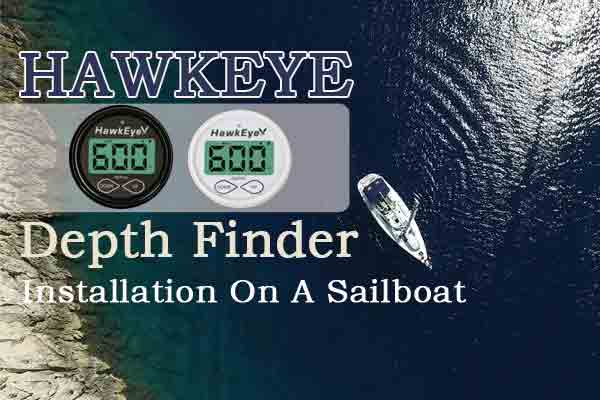
Introduction:
Installing a depth finder, also known as a depth sounder or fish finder , is a valuable addition to any sailboat. It provides crucial information about the water depth beneath the vessel, aiding navigation and ensuring safe passage. While the process may seem daunting, this comprehensive guide will walk you through the step-by-step installation of a depth finder in your sailboat. By following these instructions, you'll gain the necessary knowledge and confidence to undertake this project and enhance your sailing experience.
I. Understanding Depth Finders:
Before diving into the installation process, it's important to understand the basic principles of depth finders . These devices utilize sound waves to measure the distance between the boat's transducer and the bottom of the waterbody. The transducer emits sound waves that travel through the water and bounce back after hitting an object, which is typically the seabed. By measuring the time it takes for the sound waves to return, the depth finder calculates the water depth and displays it on a screen.
II. Gathering the Required Tools and Materials:
To begin the installation process, gather the necessary tools and materials. This typically includes a depth finder unit, a transducer, a mounting bracket, a power source (battery or connection to the boat's electrical system), appropriate cables, connectors, and a drill with various bits. Additionally, you may need sealants, waterproofing materials, and wire connectors, depending on your specific boat and the installation method chosen.
III. Selecting an Installation Method:
There are two common installation methods for depth finders : through-hull and transom mount. Through-hull installation requires drilling a hole through the boat's hull, while transom mount involves attaching the transducer to the exterior of the hull. The choice between the two methods depends on your boat's design, preferences, and requirements. Consider factors such as ease of installation, accuracy, and potential interference when selecting the installation method that suits your sailboat best.
IV. Preparing for Installation:
Before installing the depth finder , conduct thorough research and consult your boat's manufacturer or relevant experts to ensure a seamless installation process. Identify an ideal location for the depth finder unit, ensuring it is easily visible and accessible while sailing. Locate a suitable mounting spot for the transducer, considering factors such as water flow and interference. Carefully read the manufacturer's instructions to understand any specific requirements or precautions.
V. Installing the Depth Finder:
Mounting the depth finder unit: Determine the ideal location for the unit, ensuring it is secure and protected from water exposure.
Use appropriate mounting brackets or hardware to securely attach the unit to a bulkhead or dashboard.
Route the necessary cables to connect the unit to the transducer and power source, ensuring proper cable management.
Installing the transducer: For through-hull installation, carefully drill a hole in the boat's hull at the chosen location, following the manufacturer's guidelines. Apply sealant around the hole and insert the transducer, ensuring a watertight seal. Connect the transducer cables to the depth finder unit, routing them through appropriate channels or conduit for a clean and organized installation. For transom mount installation, select an appropriate location on the exterior of the hull, ensuring it is below the waterline and away from any interference. Use the mounting bracket provided by the manufacturer to securely attach the transducer to the transom. Connect the transducer cables to the depth finder unit, routing them through the boat's hull or along the transom, protecting them from damage. Powering the depth finder: Connect the depth finder unit to a suitable power source, either a dedicated battery or the boat's electrical system, following the manufacturer's instructions. Ensure the power connection is secure and protected against water intrusion.
VI. Testing and Calibration :
After completing the installation, thoroughly test the depth finder to ensure it is functioning correctly. Take the sailboat out for a sea trial and verify that the unit accurately displays the water depth . Make any necessary adjustments or calibrations as per the manufacturer's guidelines.
Conclusion:
Installing a depth finder in your sailboat is a rewarding project that enhances safety and navigation capabilities. By understanding the principles of depth finders, selecting the appropriate installation method, and following the step-by-step instructions provided in this guide, you can confidently undertake the installation process. Remember to prioritize safety, consult manufacturer guidelines, and seek professional assistance if needed. With a successfully installed depth finder, you'll gain valuable information about water depths, ensuring a more enjoyable and secure sailing experience.
- Choosing a selection results in a full page refresh.
The 5 Best Depth Finders For Sailboats – Reviews & Buyer’s Guide

Table of Contents
“As an Amazon Associate I earn from qualifying purchases at no additional cost to you”
Gauging the depth of the sea is an essential aspect of sailing, and if you do not have it, then the whole experience can easily be ruined. You will be left worrying about safety as it is dangerous to sail without knowing the depth, but our article will help you find the best depth finder for the sailboat.
However, on the internet, you will find a lot of fish finders instead because both incorporate sonar. In addition to sonar, the depth finders are equipped with GPS and WIFI to ensure your safety which the fishfinders also have, but they do not come with precision. So, long story short, if you want the best precision, a depth finder is your best choice.
But the critical question is, which is the best depth finder for sailboat? Given the numerous options in the market.
Therefore, we have gathered a list of the 5 best depth finders. By the end of this article, you’ll be able to pick the best depth finder for sailboat with great ease.
1. HawkEye DepthTrax 1B Finder For Sailboat

The HawkEye DepthTrax 1B is very accurate. They are made to provide the most precise reading ranging from 2.5 feet to 200 feet, even at the speed of 60 mph. It even allows you to take a depth reading through fiberglass hulls via its Shoot-Thru sonar technology, making it the best depth finder for sailboat.
It comes with a glare-free display that makes it easier for everyone to use. The device can be used with or without sunglasses as it has a storage sun cover. The HawkEye DepthTrax 1B also has a transom mount and glue-in-hull transducer to make it user-friendly. Furthermore, it has a backlight to aid the users in taking readings during the dark.
Safety Warnings
The HawkEyes has a safety warning feature that alerts the user whenever they are about to enter the shallow waters so that you can easily sail without knocking your boat on the ground. The device can operate for individual boats, too, with the keel offset function.
- Durable and waterproof
- User-friendly
- It comes with a 2-year warranty
- Let s you set a depth limit and alarms you when you hit that limit
- Glare-free display
- Can give an inaccurate reading in the presence of a nearby object.
2. Garmin Striker 4 Transducer

Dual Functionality
The Garmin striker 4 transducer is not only one of the best depth finder for sailboats, but it also works as a fish finder. Apart from that, this device even offers the option of omitting a transducer because of the built-in HD-ID sonar.
The device can take readings up to 2300 feet due to its 4000 watt power. It comes with buttons on the interface, making it easy to use. The large 5- inch colored display helps take the reading even when the sun is glaring right above you.
The device contains a sweep sonar technology that displays the depth and shows the contours of the bottom, including any object underneath. The high-sensitivity GPS can help you get back to a marked location via waypoint map features that enable you to pinpoint locations.
- Easy to install
- Has temperature readings
- Waterproof and quite durable
- Alarm system for shallow water alerts
- It comes with a fishing option
- It can get too complicated because of the amount of information offered
3. Faria 13751 Chesapeake Black Depth Sounder

The Faria depth sounder can be mounted with relative ease using its in-hull or transom mount transducer. The device can take depth readings from 3 feet to 199 feet, adjusted using the programmed keel offset function.
Alarm System
Faria depth sounder contains both visual and audible alarms to warn users when they are about to enter shallow waters or deep waters. So that necessary action can be taken. It is also user-friendly and easy to install the device. The options for shallow and deep water can be easily programmed with buttons on the interface.
The device is made to elevate the look of your boat with its black series, which has a sleek perimeter-lighted dial together with trendy blue and white graphics. Furthermore, the Faria depth sounder comes with a stainless steel bezel, a domed glass lens along a contoured white pointer.
- It has a fantastic display
- Easily mountable
- It has accurate readings
- It can be fitted anywhere
- Comes with a short transducer cord.
Handheld Depth Finders
4. lucky kayak portable fish depth finder.

Colored Display
The Lucky Kayak is a multi-purpose device that works as both a depth and a fish finder. It comes with a colored and clear display that also shows the contours of objects underwater, along with its sensitivity feature that lets you choose clearer and more professional image results. The Kayak fish finder feature can easily detect the temperature and altitudes underwater.
The device has an alarm system that notifies you whenever you hit shallow waters. It also has a changeable setting that lets you change the units and language as per your ease.
Portable Charger
The Lucky kayak depth finder can last up to 5 hours without charging. It has a portable charging USB cable along with adjustable brightness. The device has numerous modes, along with a bracket that can be easily attached to your ship or kayak.
- Best displays
- Different modes
- Offers depth and temperature reading
- Easy to mount
- Most features are related to the fish finder functions.
- Not user friendly for users whose primary aim is depth readings
5. HawkEye DT1H Handheld Depth Finder

The HawkEye DT1H is a handheld depth finder with an accurate depth measuring feature that can gauge depth from 1.5 to 200 feet. The equipment is waterproof till 200 feet. The readings are constantly updated with the HawkEye DeepThrax sonar feature that emits pulses four times per second with a beam angle of 14 degrees.
The Hawkeye DT1H is made with ABS plastic designed in such a way, making it almost unbreakable with the help of inductive switching technology. It features several magnets to manage user commands and successfully omits to switch holes, with its unique design.
Versatility
The device can read both water and air temperature in your desired units. It also has a Softglow backlight LCD for an overall anti-glare effect coupled with an incorporated lanyard and a dot-matrix dual display frequency. It has a smart sonar water depth detection feature, making us think that this is one of the best depth finders for a sailboat.
- It has two transducers
- Easy to install and operate
- It is waterproof and has a very durable structure
- The readings are accurate and precise
- Cannot take accurate readings in muddy waters.
Frequently Asked Questions (FAQs)
1. what is the easiest depth finder to use.
All the depth finders are generally easy to use. However, the HawkEye DeepTrax 1H is the easiest to use because it is handy and has a rigid plastic body with easy-to-understand features.
2. Is a depth finder the same as a fish finder?
A depth finder and a fish finder are not the same devices. However, both use the same sonar technology and transducers to produce graphic images. Hence why, often, people confuse them to be the same.
3. Which is better, Garmin or Lowrance?
Both the brands are excellent in their capacity. But Lowrance is better for people with a lower price budget, whereas Garmin has a higher price point but a better GPS finder and a more stylish design.

4. Do you need a depth finder on a boat?
Yes! They are a mandatory accessory when it pertains to sailing for safety reasons. This navigation tool will prevent you from being stuck in shallow waters. Moreover, they will help you identify any structure or object in the water.
Buying Guide – How To Choose The Best Depth Finder For Sailboat
If you love sailing or have a job that requires you to sail a lot, you must buy the best depth finders for your sailboats. But before making a purchase, do keep these factors in mind.
Transducers
Transducers are essential to any depth finder. They emit waves that bounce off against any object in the water. In addition to that, they send and receive sonar waves which are picked up by the transducers. Transducers have different mounts; the bigger the boat, the bigger the mount will be.
Transducer Materials
The material of the transducers depends on the kind of boat a person has. If a person sails for fun, he can have a simple plastic transom mount.
However, the best transducer materials for housing are bronze for boats with wood or fibreglass. In contrast, stainless steel or aluminum housing is for steel, and transducers with full in-hull mount require plastic housing.
Beams and Cone Angles
The cones’ angles show the width of the ray emitted from the boat to the water. It is an essential aspect to consider when making a purchase. A wider cone denotes that a person will cover a wider area. The cone angle expands once the beams move lower, indicating that it will lose sensitivity in deep waters.
Comfort and Usability
Before buying a tech device, it is essential to understand that device because many times, people are unable to grasp the features of a device. One should look for depth finders with simplified features based on your tech capabilities to understand the readings.
Colored Displays
Nowadays, most of the devices come with a colored display. They make it easier to understand the information being given by your transducer. It will broaden your vision and help you see what is going on.
On the other hand, a black and white display is difficult to decipher, especially in direct sunlight. They are also incomprehensible in cloudy weather, making the colored screen a must-have feature in your search for the best depth finders for sailboats.
Final Verdict
Depth finders will take your sailing game up a notch. They elevate the overall sailing experience and aid in safety precautions. Initially, it can seem a bit pricey, but once you start using them, you will see the numerous benefits they offer. We hope this article helps you find the best depth finder for your sailboat.

Bill is an ISA Sailing & Powerboating Instructor in Ireland. He writes about all things sailing.
Related Articles that might be of interest to you:

The 5 Best Buoyancy Aids For Dinghy Sailing – Reviews & Buying Guide
“As an Amazon Associate I earn from qualifying purchases at no additional cost to you” Are you looking for the best US coastguard-approved PFD for dinghy sailing and laser sailing? Then you’re in luck. In this article, we at WindyHQ have made it our sole responsibility to bring to you

The Best Sunglasses for Dinghy Sailing
“As an Amazon Associate I earn from qualifying purchases at no additional cost to you” Sunglasses are an important accessory for dinghy sailing. When out at sea, the sun and the wind are two essential elements that can be expected to play a role in the sailing experience of each

The 5 Best Shoes for Dinghy Sailing – Expert’s Guide
“As an Amazon Associate I earn from qualifying purchases at no additional cost to you” Answering the call of adventure by dinghy sailing requires you have all the right equipment at hand. You cannot go dinghy sailing with a pair of office shoes; you need proper water shoes that work
Leave a Comment Cancel Reply
Your email address will not be published. Required fields are marked *
- Techniques & Guides
- Yacht Equipment
- Personal Gear
Made by Dancing Data.
Disclosure . Terms and Conditions . Privacy Policy

- Gear Directory
- Multihull Sailor
- Boats for Sale
- Real Estate
- Maintenance & Hardware
- Water Sports
Sail Confidently With the Best Depth Finders
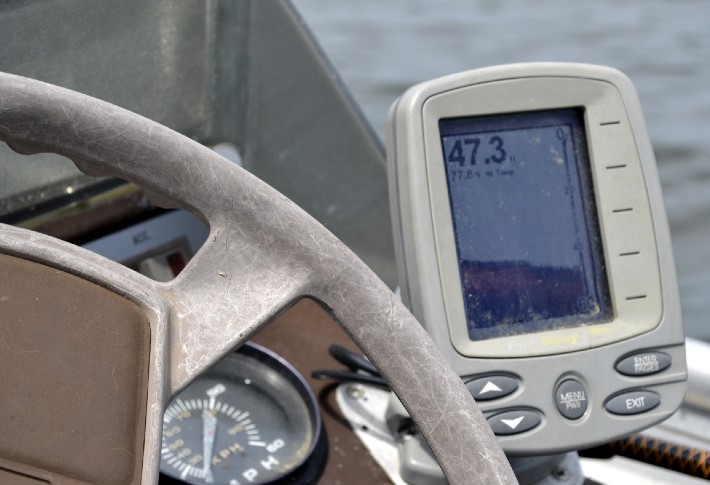
Our content is meticulously curated through independent research, testing, reviews, and AI-driven recommendations, all designed to present you with the finest product choices. When you make a purchase through our links, it could result in us earning a commission.
Whether you are looking to reel in fish or just spend some relaxing time on the water, a depth finder is one gadget you should have in your boat. And if you are looking for the top depth finders in 2024, this guide is just for you.
Depth finders also called echo finders, are simply devices used to determine the depth of a water body just below the surface. They work by measuring the time taken for sound to be reflected or echoed back from the bottom – since the speed of sound in water is constant and known, the longer it takes for the echo to be reflected, the deeper it is to the bottom.
But not all depth finders are made equal – between the different brands, designs, and price points, the options can easily get overwhelming. And some depth finders are dedicated while others aren’t.
To save you the shopping hassle, we have compiled a list of depth finders that stand out from the rest.
Our Top Picks
- Top Pick: LUCKY Wired Depth Finder Shop Now ➔
- Runner Up: HawkEye DT1B Depth Finder Shop Now ➔
- Honorable Mention: Humminbird HDR650 Depth Finder Shop Now ➔
- Contender: RICANK Depth Finder Shop Now ➔
- 1 Are Depth Finders the Same as Fish Finders?
- 2 What Factors Should I Consider Before Buying a Depth Finder?
- 3 Intended purpose and water profile
- 4 Gauge design
- 5 What Are the Different Types of Transducers?
- 6 Thru-hull transducers
- 7 In-hull transducers
- 8 Transom transducers
- 9 Connectivity
Do depth finders make noise?
Can i use a fish finder as a depth finder, how much do depth finders cost, related content, detailing our favorite depth finder of 2024.
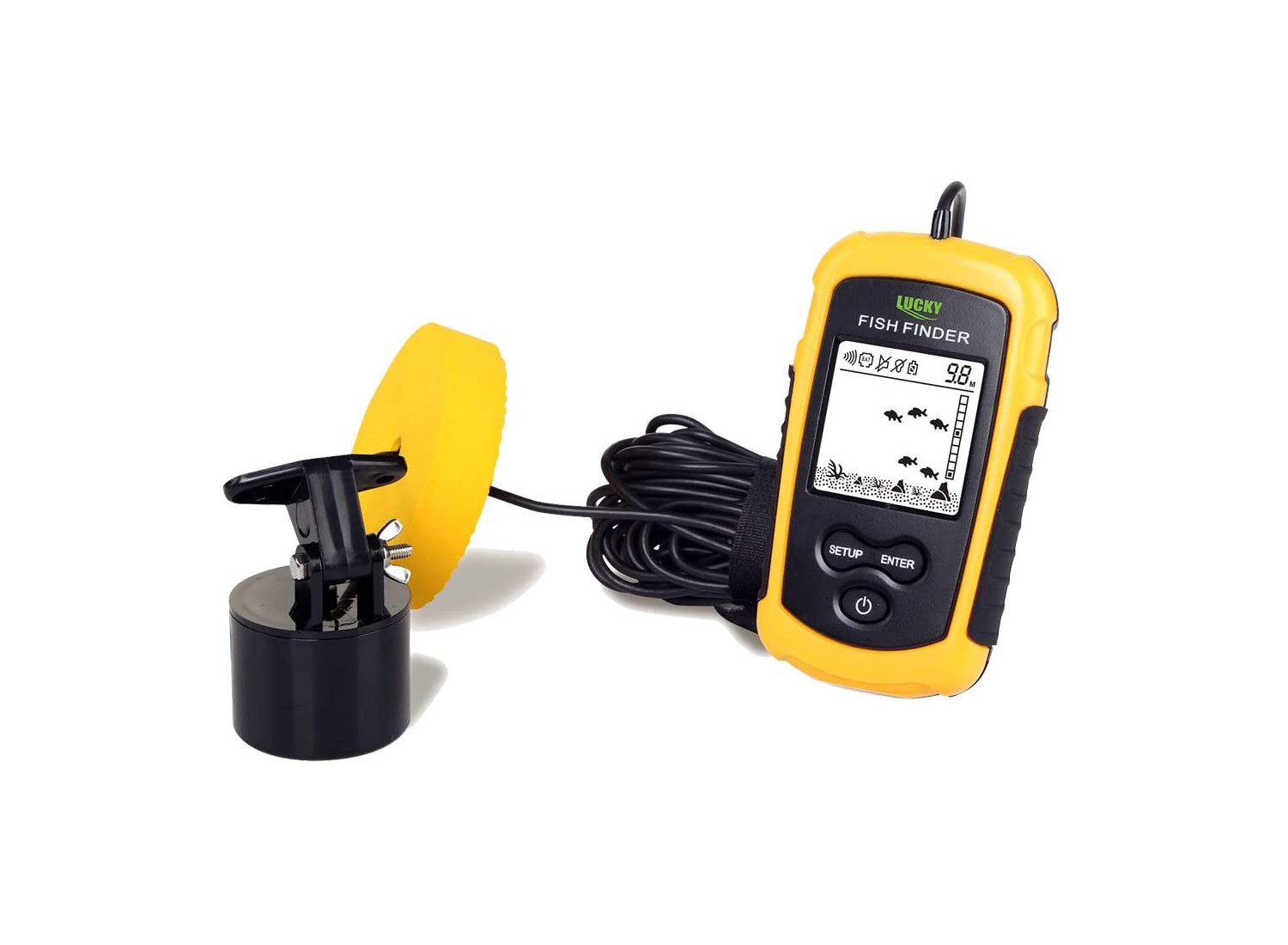
LUCKY Wired Depth Finder
This depth finder finds depth and some more – it is also a fish finder. It is a great buy for water sports enthusiasts and anglers who want a handy depth finder to use in shallow to medium-depth water.
- It is very versatile
- It is budget-friendly
- It is portable and can be used in different ways
- Its depth measurement is limited
- It is handheld and may easily get misplaced
Key Features
The LUCKY depth finder comes as a wired depth finder with a digital handheld unit that connects via a 7.4 m cable to its 200 kHz 45° wide-angle transducer. It measures up to 100m depths, comes with a fish alarm, and displays profiles and locations of fish, plants, and debris. It is very portable and comes with extra accessories including a float, neck strap, and mounting bracket, and also costs $41.
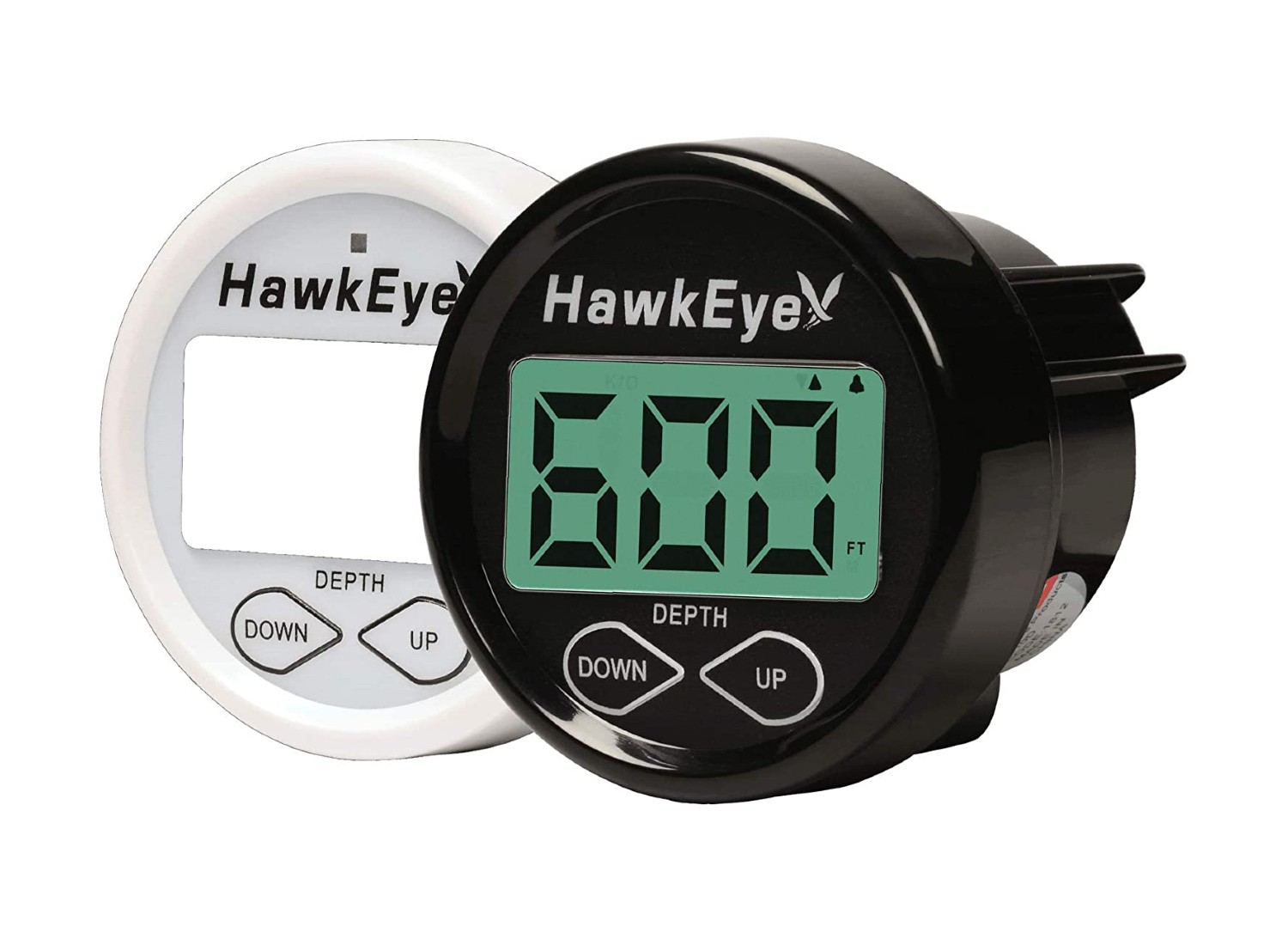
HawkEye DT1B Depth Finder
This dedicated depth finder is great at the only thing it does – finding depth. It is easy to install, fits both slow and fast boats, and is exceptionally user-friendly.
- It boasts superior depth measurement
- It is intuitive and user-friendly
- It is easy to install
- It can only measure the depth
- Its display is very basic
The HawkEye DT1B depth finder includes a digital gage that’s small enough to fit into most gage openings and comes with two interchangeable bezels to fit your boat’s accent. It features a multi-mount transducer engineered to give accurate depth readings to up to 600 feet below the surface and at up to 60 mph and includes a transom mount and in-hull mount among other installation accessories for mounting ease. The digital gage is user-friendly with a polarized backlit display to maximize visibility, features a 3-stage alarm system, and runs on algorithmic software for maximum accuracy. It goes for around $87.
Honorable Mention
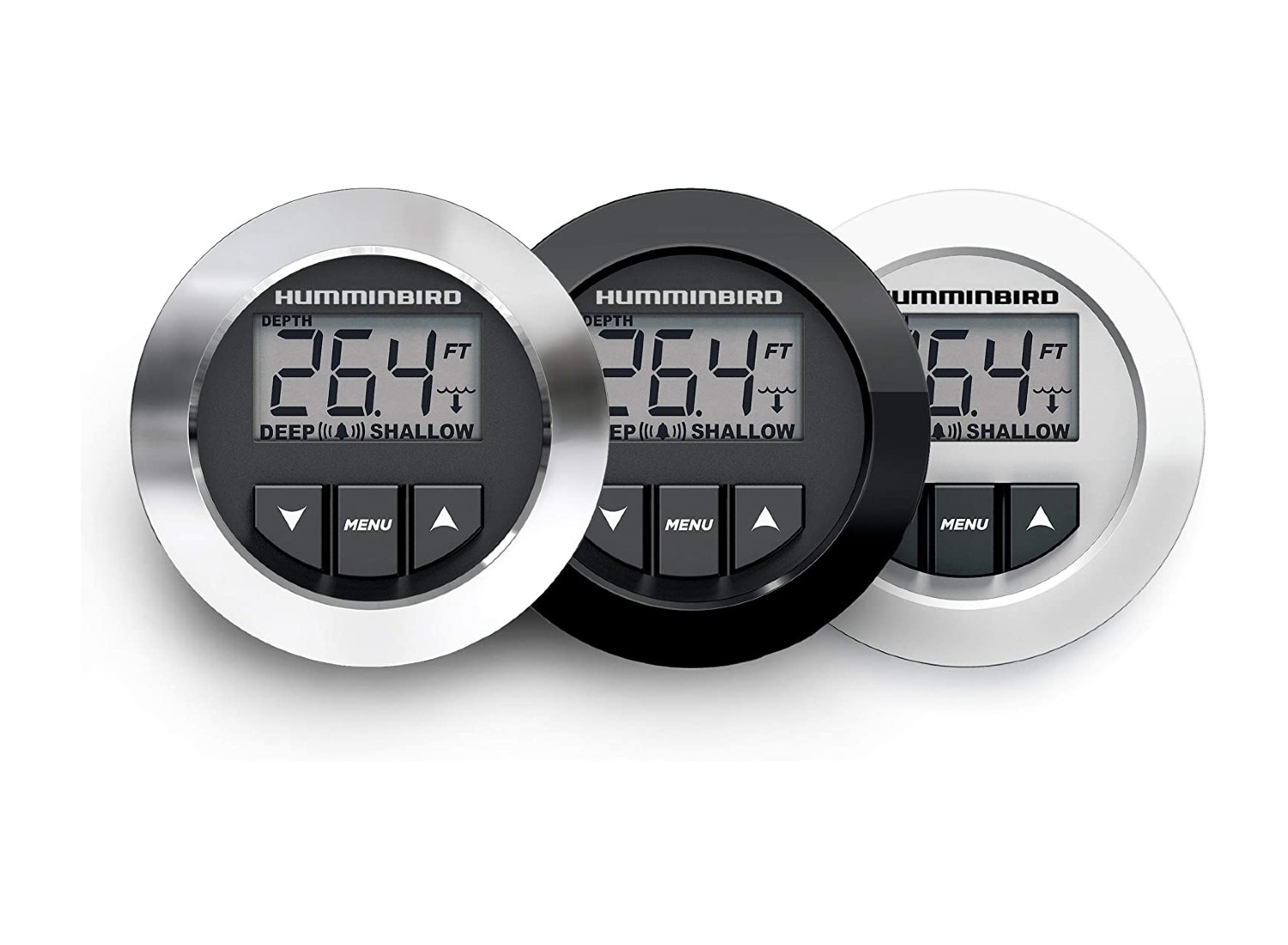
Humminbird HDR650 Depth Finder
This depth finder is designed to blend right in with your boat’s dashboard or instrument panel. It is exceptionally versatile for different boat profiles, is easy to install, and won’t interfere with your boat’s performance.
- It performs well even at high speed
- It is user-friendly and intuitive
- It is quite pricey
- It only measures depth
The Humminbird HDR650 depth finder features an in-dash digital gage with intuitive controls, a waterproof seal, and three customizable bezels for different boat dashboard accents. The transom-mounted sonar transducer measures up to 600 feet below the surface and at up to 70 mph and also includes all its mounting accessories. The whole unit costs around $110.
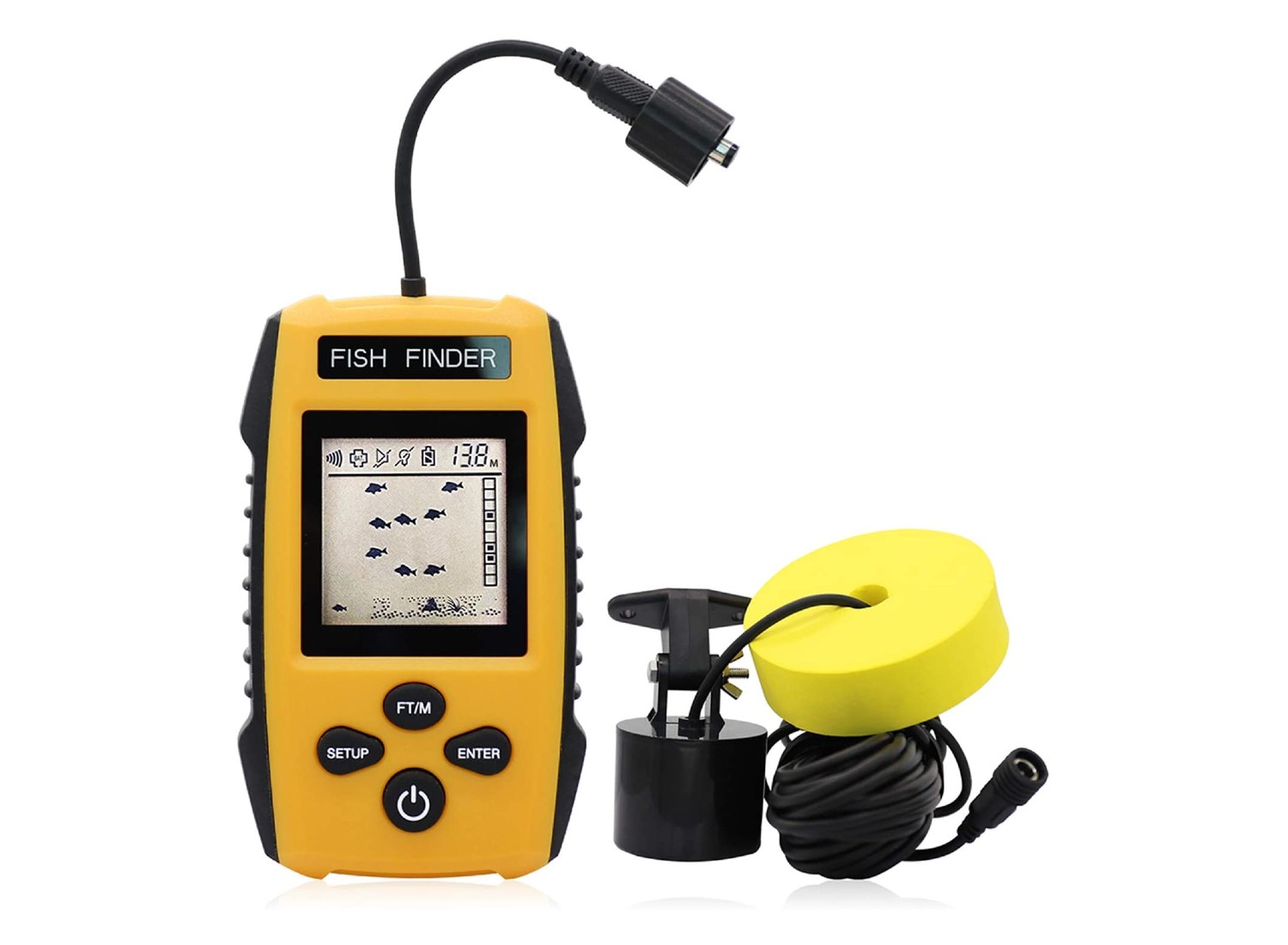
RICANK Depth Finder
This depth finder is the ideal tool for the angler or water sports enthusiast on a budget. It packs a depth and fish finder into one and is exceptionally versatile in different environments.
- It can be used in different environments
- It is not the ideal high-end option
- It has a limited depth range
The RICANK depth finder shares some features with the LUCKY depth finder including its digital gage that gives a fish and contour profile, 25-foot connection cable, handheld design, and intuitive controls. Its transducer can be used with the included float or fixed to the boat and gives accurate readings at up to 100 feet below the surface with its wide-angle 45° sonar beam. The gage also comes with great battery life, giving a 5-hour running time on its batteries, and other accessories are included for the most functionality.
Finding Your Next Depth Finder: A Buyer’s Guide
Knowing the depth below the water surface can help you navigate your boat safely and avoid obstacles as you move. Enter depth finders – the way they use sonar or sound to determine depth has not changed much. However, depth finders are slowly being replaced by multi-purpose units targeted toward different boating needs, and finding a dedicated depth finder can be a little hard.
Earlier on in this guide, we gave you an outline of the best depth finders on the market but you may still be in a fix as to which to choose. We’re still here to help. In the rest of this buying guide, we will take a look at some of the deciding factors we considered and which you should too so that you can zero in on the perfect depth finder for your boat. We will also take a look at some must-have qualities for depth finders before you make a purchase.
Are Depth Finders the Same as Fish Finders?
For newbies, the difference between depth finders and fish finders can get confusing. Many platforms even use them interchangeably, only fueling the misconception that they are the same. In reality, they are not. Well, not completely. Depth finders are devices used solely to determine the depth of the bottom from the surface. Fish finders, on the other hand, are designed with anglers in mind to find fish below the surface. Many fish finders may include a ‘depth finder’ feature but the reverse is not usually the case. As depth finders are dedicated, they use lower frequency sound waves and measure the depth to a far greater range than fish finders.
What Factors Should I Consider Before Buying a Depth Finder?
Intended purpose and water profile.
What exactly are your intentions on the water? Do you want a depth finder to use when sailing, kayaking, fishing, or when on your boat leisurely? Your intended purpose will determine the type of depth finder you get or whether you get one at all.
Where you’ll be using your boat will also determine the depth finder you buy. Sailing in the ocean will require a depth finder that can detect o much lower depths than another you’ll be using while on a lake.
Gauge design
The gauge or display unit of the depth finder must be very user-friendly and come with intuitive controls. Many times, dedicated depth finders will come with displays in black and white. Fish finders, on the other hand, emphasize being able to see fish and the bottom profile, and will often with colored digital displays.
The gauge on the depth finder should also be easily integrated into your boat panel. It should fit into standard boat dashboards or cup holders and should blend with its accent. To ensure this, many depth finders include extra gauge bezels in common boat dashboard colors that are easily interchanged.
What Are the Different Types of Transducers?
The transducer on the depth finder is where all the action happens. Depth finder transducers can be categorized based on how they are mounted and their frequency ranges. However, as depth finders typically work in a tight frequency range (between 15-50 kHz) we will only consider transducers based on how they are mounted.
Thru-hull transducers
Thru-hull transducers are screwed into a hole drilled in the hull of your boat. They offer the most secure fit and minimum drag through the water, but their performance may be affected when the boat moves at high speed.
In-hull transducers
In-hull transducers send the sound signal through the hull of the boat and are mounted inside the boat. They offer the most minimal effects on the boat’s performance but are only suited to thin boats made from materials like fiberglass that won’t absorb the sound.
Transom transducers
Transom transducers are mounted on the stern of the boat. They are the easiest to install and are suited to smaller boats.
Connectivity
How the gauge connects to the transducer is another important factor to consider. Most depth finders will come with a wired connection that uses a plug and port. However, some high-end depth finders may feature wireless connectivity that may even be integrated with your mobile device or GPS for added functionality.
People Also Asked
Low-frequency depth finders that produce sound waves between 15-20 kHz can be heard as this falls within the 20 Hz-20 kHz audible range. Any sound above 20 kHz, however, cannot be heard.
Many fish finders can be used as a depth finder, but to a limited range. Average fish finders have a depth range of about 100m (320 feet) below the surface, thanks to their high-frequency wide-angle sound beams. Depth finders, on the other hand, can detect depths as low as 600 feet and more.
Depending on the type and design, basic depth finders will typically sit between $20-$200. In general, dedicated depth finders are more expensive than depth finders which are also fish finders.
Article Contributors
Sail magazine review team.
SAIL Magazine Review Team reports on best-selling products in sailing and boating. The SAIL Magazine editorial staff is not involved in the creation of this content. SAIL Magazine is reader-supported: When you buy through links on our site, we may earn an affiliate commission. The SAIL Review Team is composed of authors, editors, and sailors. Artificial Intelligence (large language models) may have been used in the research and creation of the content.
To ensure questions about product testing or a specific article are addressed, please contact [email protected]
- 2024 BOAT BUYERS GUIDE
- Email Newsletters
- Boat of the Year
- 2024 Freshwater Boat and Gear Buyers Guide
- 2024 Boat Buyers Guide
- 2024 Water Sports Boat Buyers Guide
- 2023 Pontoon Boat Buyers Guide
- Cruising Boats
- Pontoon Boats
- Fishing Boats
- Personal Watercraft
- Water Sports
- Boat Walkthroughs
- What To Look For
- Best Marine Electronics & Technology
- Watersports Favorites Spring 2022
- Boating Lab
- Boating Safety

Mounting an In-Hull Transducer on a Boat
- By Jim Hendricks
- Updated: April 13, 2020
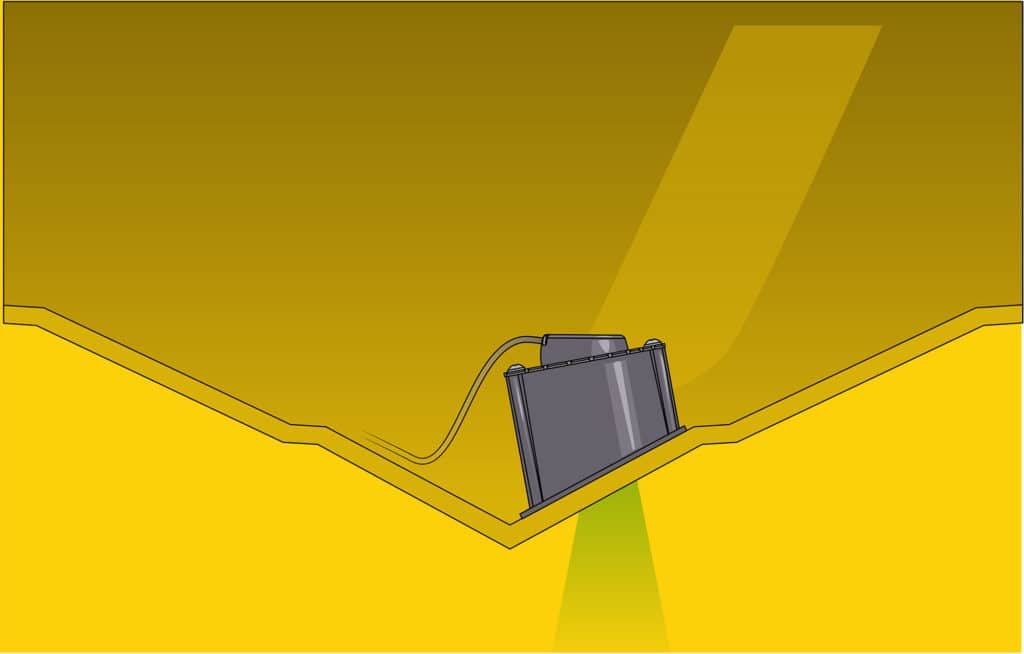
An in-hull (aka shoot-through) transducer mounts to the inside of the hull and transmits and receives sonar signals through fiberglass, eliminating the need for drilling holes in the hull.
This also eliminates the need to remove the boat from the water for installation, and there will be no protrusions under the boat. But there are downsides. For one, the transducer must be mounted on solid fiberglass; in-hull transducers will not function in cored fiberglass hulls without special modifications. Also, in-hull models exclude a sea-temp or speed sensor, so those will have to be added externally on the transom, if desired. That said, a properly positioned in-hull transducer offers outstanding performance when looking for fish and bottom features, with only minimal loss in range at the deepest capabilities of the transducer.
Read Next: Ask Ken: Install a Transducer Without Drilling a Hole in the Hull
One of the latest in-hull models is the M285HW chirp-ready transducer from Airmar. It operates at 1,000 watts on a — high-frequency band of 150 to 250 kHz with a fixed beam angle of 25 degrees for maximum coverage under the boat out to depths of 500 feet. The base easily compensates for deadrise angles ranging from zero to 22 degrees to ensure the beam shoots straight down. This is critical for optimal performance and accurate depth readings. It is suitable for powerboats up to 25 feet in length. Before getting started, make sure the transducer and the plug are compatible with your sonar unit.
Skill Level: 2 of 5
Finish Time: Approx. 3 hours (excluding on-water testing)
Tools and Supplies
• Airmar M285HW in-hull transducer ($741.99, anchorexpress.com )
• Disc sander
• Thin, sealable plastic bag
• Cable ties
• Broomstick
• Protractor or iNstall app
• Straightedge
• Carpenter’s square
• Phillips screwdriver
• Isopropyl alcohol and shop rags
• 14 oz. propylene glycol ($6.49/Star brite 28 oz., westmarine.com )
• Adhesive such as Marine-Tex ($36.99/ 14.6 oz., jamestowndistributors.com )
• Mixing cup and stir sticks
• Petroleum jelly
• Electricians snake (for routing cables)
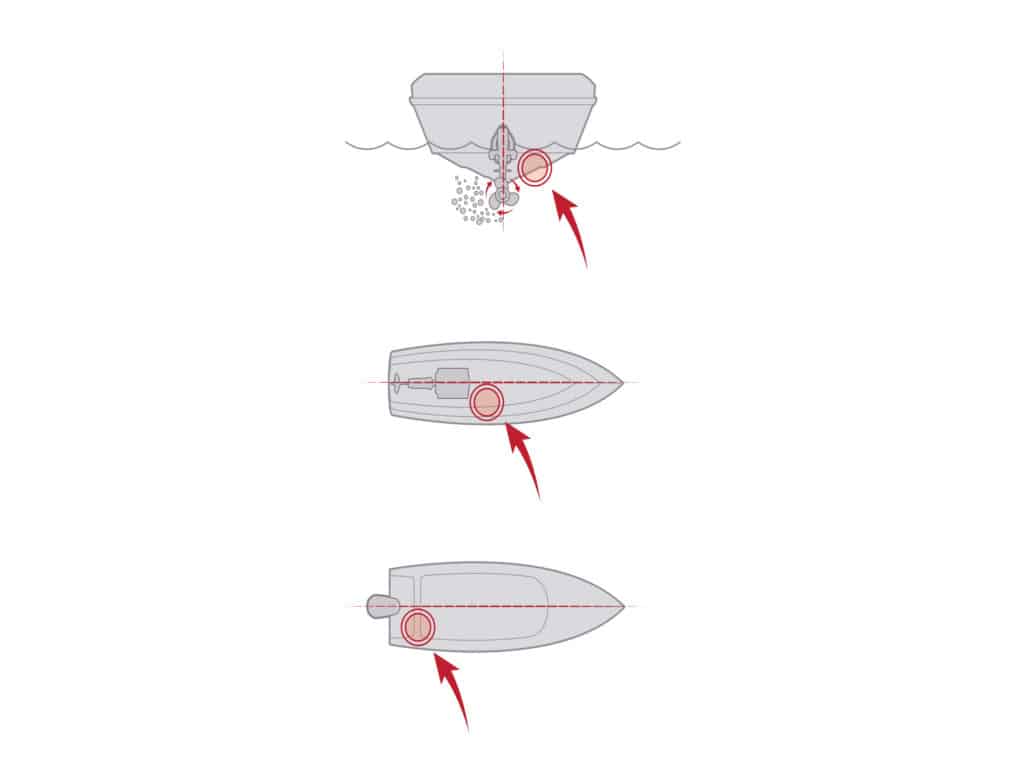
Though the transducer is inside the hull, it is crucial that there are no external strakes, intakes or other hull features that would cause aerated water to flow over the transducer’s location. Location depends on the type of hull and propulsion. On inboard planing hulls, just ahead of engine(s) and prop shafts is the best spot; displacement hulls allow for positioning farther forward. On outboards and sterndrives, an aft location is optimal, except on step hulls, which necessitate placement forward of the steps. Locate the transducer as close to the centerline as possible, If the mounting surface is not smooth, grind it flat with a disc sander.
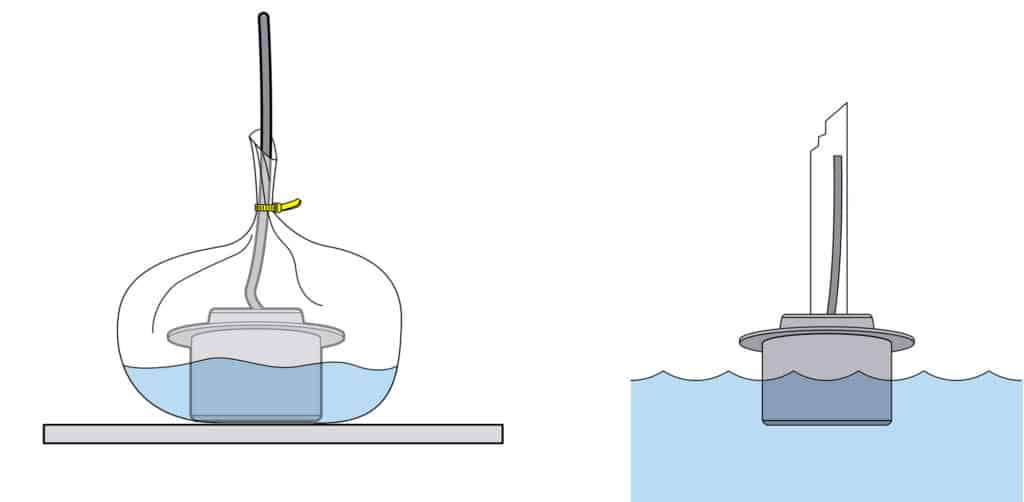
Establish a performance baseline by connecting the transducer to the fish finder and hanging the transducer overboard with the boat floating at rest in at least 25 feet of water and viewing the bottom return. At the same site, test the transducer inside the hull at the selected location. Place the transducer inside a thin plastic bag partially filled with water and cinched tightly with a cable tie. Wet the mounting surface and press the active face of the transducer against the hull. Compare the bottom return to the baseline, and if the reading is similar, the mounting location is good. If not, you will need to find another location and repeat the test.
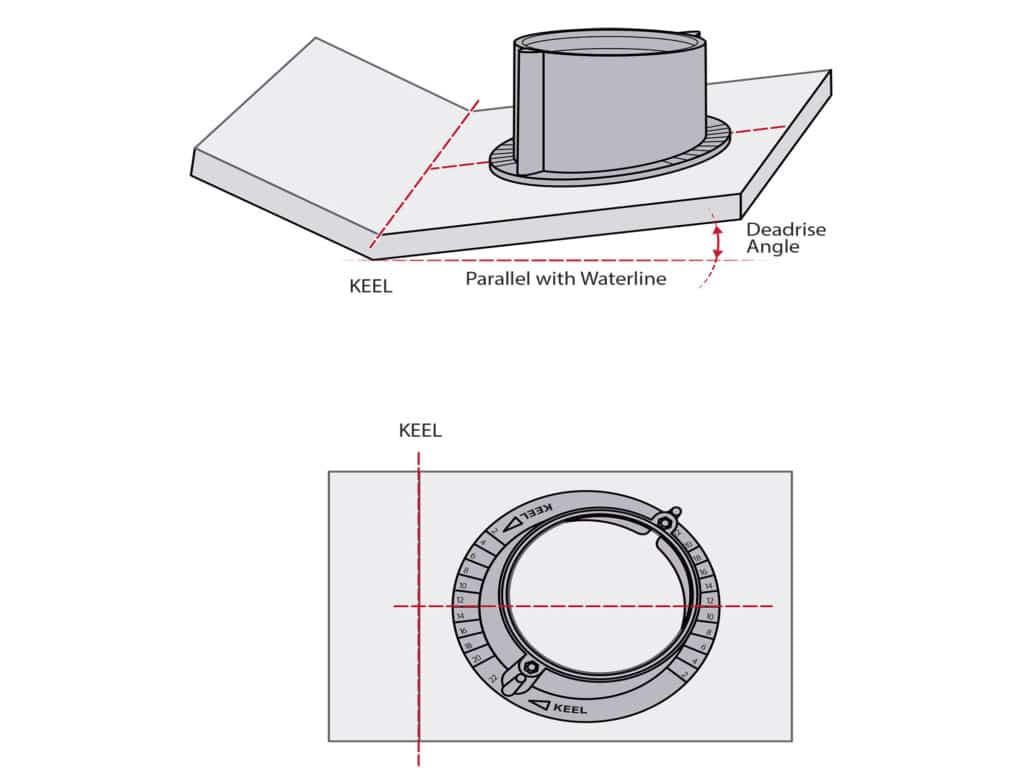
Measure the deadrise — the angle of the boat’s V — at the mounting location. A free app called iNstall enables your phone to be used to determine the deadrise angle. Another way is to create a straightedge either inside or outside the hull that runs parallel to the waterline, then use a protractor to find the angle. Using a carpenter’s square, draw a line on the inside of the hull perpendicular to the centerline through the center of the mounting location. Identify the number on the flange of the transducer base that corresponds to the deadrise, and find the matching number on the opposite side. These will align with the line you drew.
Tip: To prevent overheating of the liquid inside the transducer housing, mount in-hull models in cool, well-ventilated areas as far away as possible from inboard engines or other heat sources such as generators or air conditioners.
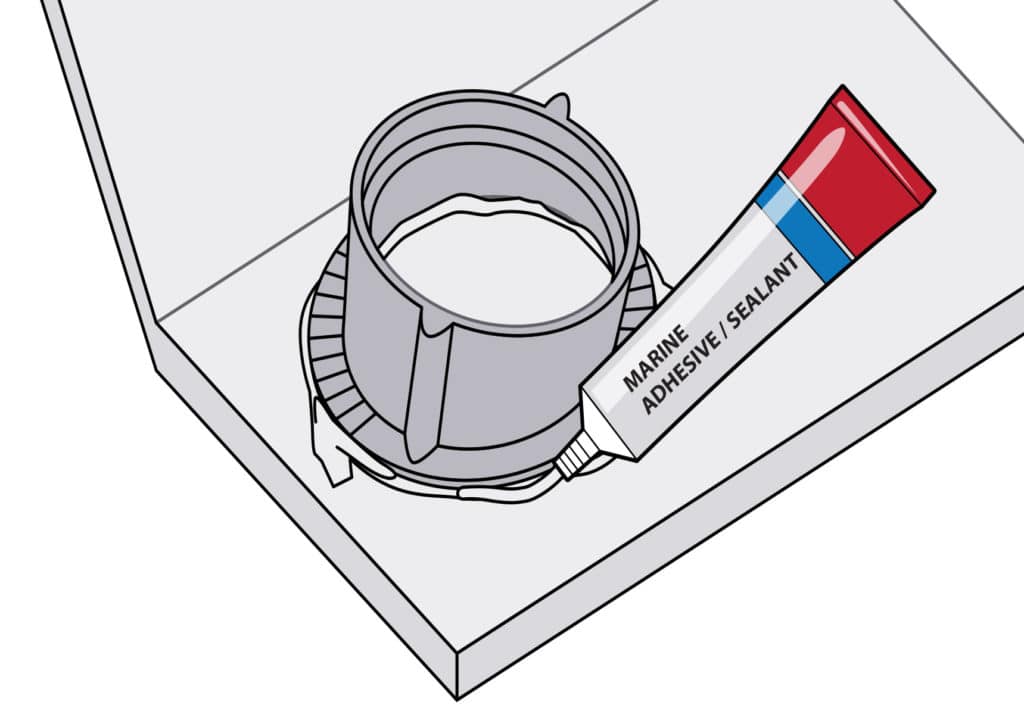
Ensure that the mounting surface is free of fiberglass wax, paint, oil or moisture. If necessary, lightly sand and clean again with isopropyl alcohol, then redraw the line that positions the base. Now you’re ready to secure the base to the inside of the hull. Remove the transducer from the base housing. Use a bonding agent such as Bondo 401, Marine-Tex Epoxy Putty or 3M 5200 Marine Adhesive/Sealant. Apply the adhesive per the manufacturer’s recommendation for optimal adhesion, and press the flange of the base firmly in place to form a liquid-tight seal. Allow the bonding material to cure per the manufacturer’s instructions.
Once the bonding material has cured, pour 14 ounces of propylene glycol (nontoxic antifreeze) into the housing. Lubricate the O-ring from the top of the housing with petroleum jelly. Carefully place the transducer into the housing to avoid causing the propylene glycol to overflow. Turn the transducer until the number on the rim that corresponds with deadrise is directly over the alignment boss closest to the keel. The transducer should drop into place. Insert a rubber washer and screw into each of the two holes by the alignment bosses. Snug up each screw to 1.3 foot-pounds. Route the cable to the fish finder and plug it in.
- More: diy projects , How-To , transducer , Weekend Workbook
More How To

I Learned About Boating From This: Capsize, Rescue and Lessons Learned
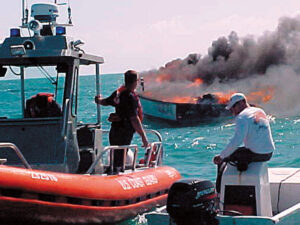
Should You Abandon Ship During a Boat Fire?

38 Top Make-Ready Tips for the Spring Boating Season
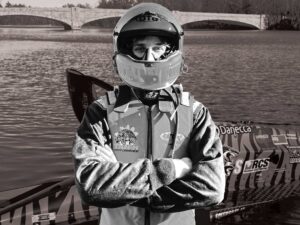
On Board With: Andrew Robbins
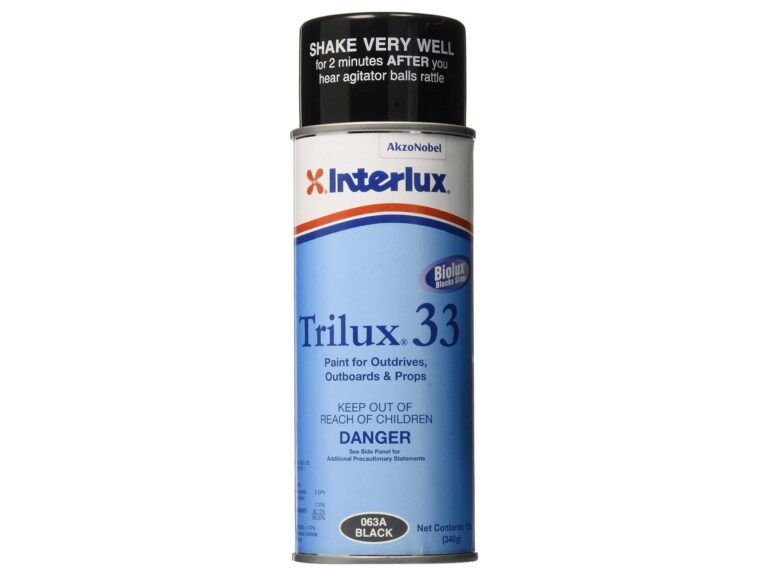
We Test Interlux Trilux 33 Aerosol Antifouling Paint

Boating Shoes for Spring and Summer

MasterCraft Celebrates International Women’s Day With Fourth Annual ‘Let Her Rip’ Campaign
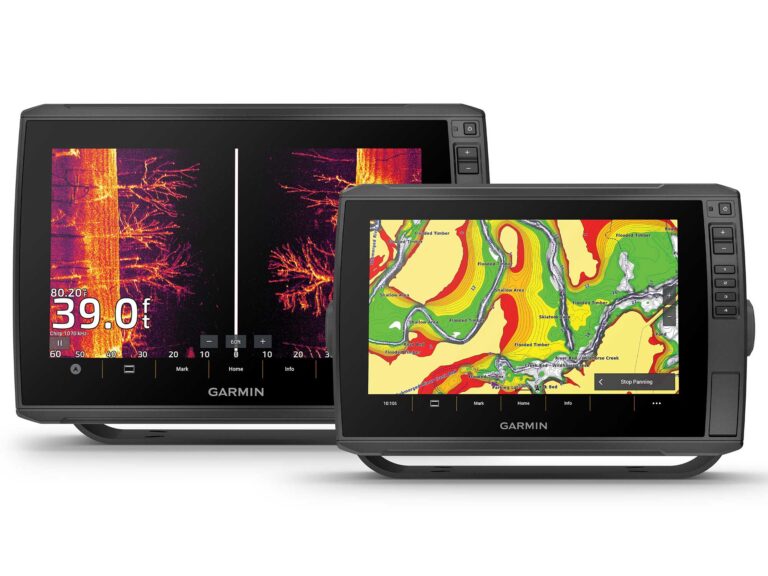
Garmin EchoMap Ultra 2 Series

- Digital Edition
- Customer Service
- Privacy Policy
- Cruising World
- Sailing World
- Salt Water Sportsman
- Sport Fishing
- Wakeboarding
Many products featured on this site were editorially chosen. Boating may receive financial compensation for products purchased through this site.
Copyright © 2024 Boating Firecrown . All rights reserved. Reproduction in whole or in part without permission is prohibited.

Where Is The Best Place To Mount A Transducer? (Top 5 Locations)
UPDATED 03 NOVEMBER 2023
by Robert Ceran
Are you wondering where to mount your fish finder transducer?
As you probably know, it’s essential to install your transducer correctly in order to get good performance from it.
Table of Contents
But choosing the right location to mount a transducer is more complicated than most people anticipate, since each location comes with its own set of challenges and pros and cons.
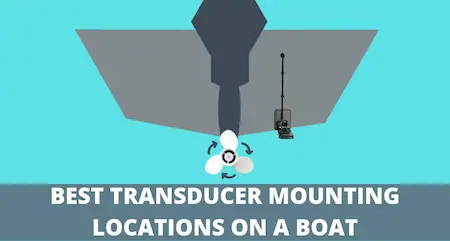
In this article we’ll go over the 5 best places to mount a transducer on a boat, and what you need to know in order to choose the right location for your transducer.
Where to mount a transducer on a boat
The top five transducer mounting locations on a boat are:
- Transom mount
- Trolling motor mount
- In-hull mount
- Thru hull mount
Out of these five transducer placement options, the most commonly used ones by far are transom and trolling motor mounts, though the other three can also be great options for specific situations and applications.
When choosing the right transducer mounting location, it’s important to keep in mind that all of these options come with their own pros and cons, and you should weigh these carefully before choosing the right one for your purposes.
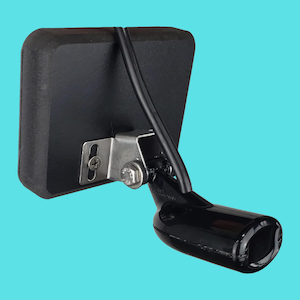
Screwless transducer mounting kit
Pad for mounting your transducer without screwing into the boat hull.
Where to mount transducer on transom
Now let’s talk about choosing the best transom mount transducer location, since this is one of the most commonly used places to mount a transducer on a boat.
Unfortunately, many anglers choose an incorrect transducer placement on the transom, and as a result they experience problems with their sonar imaging.
That’s why it’s so important to get the transducer placement right in order to achieve the best results.
What is the best transom mount transducer location?
It’s essential to mount your transducer in an area of the transom that doesn’t have any turbulence, since even a little turbulence can negatively impact the quality of your sonar image.
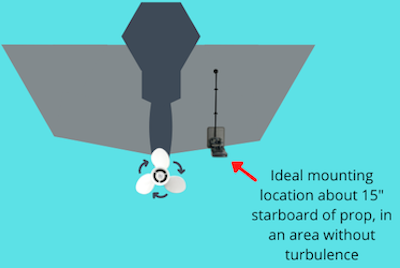
This means you should avoid areas with turbulent water flow aft of rivets, strakes, or ribs in the hull. Choose a transducer placement spot on the transom where the hull in front of this location is flat and smooth.
Also, make sure that the transducer is at least 15 inches away from the propeller of your outboard motor, and check whether the outboard can rotate fully in all directions without bumping into the transducer (which needs to be checked in the fully trimmed position).
What is the best transducer mounting height?
The best transducer mounting height is at the bottom edge of the transom, with the lower surface of the transducer protruding about 1/32 to 1/16 inches below the bottom of the boat.
It’s important to avoid mounting the transducer too high on the transom, since this will cause it to be out of the water at planing speed (keep in mind that the water level of the transom drops when the boat is on plane).
If you mount your transducer too high on the transom, this will still allow it to function at slow speeds under 2 to 3 mph. But as soon as the boat gets faster than that, the transducer will stop working.
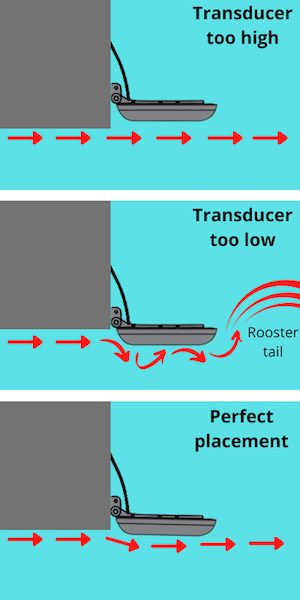
Secondly, you also want to avoid the transducer being too low on the transom, as that will trigger turbulence and rooster tail formation, which also negatively affects the quality of sonar imaging.
So the ideal transducer mounting height on the transom is with the bottom surface of the transducer just slightly protruding below the bottom of the boat (see diagram above).
How far should a transducer be in the water?
The transducer placement needs to be deep enough so that its piezoelectric crystals are fully covered by water.
This can be accomplished even if the top of the transducer is flush with the water level, but if its crystals are out of the water, the sonar can’t function, and you won’t get an image.
One thing you need to keep in mind is that the water level of the transom goes down at planing speed, and if your transducer is mounted too high, the crystals will be out of the water when you’re going fast.
Should the transducer be flush with the bottom of the boat?
No, it’s actually better if the bottom edge of the transducer protrudes by about 1/32 to 1/16 inch below the bottom of the boat.
This is just enough to ensure that it is covered by water even at planing speed, but not low enough to trigger turbulence and rooster tail formation.
If the transducer is flush with the bottom of the boat, it will still work at slower speed, but not at high speeds.
Can you mount a transducer too low?
Yes, if you mount a transducer too low, it will trigger turbulence and air bubble formation around the transducer, as well as rooster tail formation behind the transducer.
This turbulence decreases the quality of the sonar imaging, especially when your boat is planing at higher speed.
What side of the boat do you mount a transducer?
A transducer should be mounted on the side of the boat with the downstroke of the outboard propeller, which is usually on the starboard side.
An easy way to check this for your boat is to observe the direction of rotation of your propeller. If it’s clockwise, then your transducer placement should be on the starboard side, but if it’s anti-clockwise, then the transducer should be on the port side.
The side of the transom with the downward stroke of the prop has less turbulence than the side with the upward stroke, which is why it is the best transducer mounting location.
Where to mount a transducer on trolling motor
The best place to mount a transducer on a trolling motor depends on the type of transducer you’re using.
A forward facing transducer (such as LiveScope, Active Target , or MEGA Live) should be mounted on the shaft of the trolling motor, as that gives it an unobstructed view in the forward direction.
The great thing about this type of transducer mount is that it will automatically point your transducer in the same direction as the trolling motor.
However, you can also achieve this with a trolling motor barrel mount if the transducer is placed on the side of the lower compartment.
If you want to mount a 2D or down imaging transducer on your trolling motor, the best way to do this is with a barrel mount, which uses a circular mounting bracket that fits around the lower compartment of the trolling motor.
This mounting location is ideal for pointing the transducer downwards without obstructing its view.
The best locations to mount different types of transducers
Now let’s take a closer look at different types of transducers, and the best mounting locations for each of them.
Where to mount a side imaging transducer
The best location to mount a side imaging transducer is at the transom, since that usually allows its sonar beams to shoot sideways in both directions while you’re driving the boat around, which enables you to scout large areas of water to both sides without having to slow down.
But when mounting a side imaging transducer on the transom, you need to take care that you put it in a spot where it isn’t blocked on one side by the outboard motor when it is fully trimmed down.
Where to mount a down imaging transducer
The best location to mount a down imaging transducer is either the transom, or the trolling motor.
Which transducer placement is best for you depends on whether you plan to use the down imaging while you’re driving around (in which case a transom mount is best), or while you’re fishing (in which case a trolling motor mount is best).
If you mount your transducer on your trolling motor, the best option is a barrel mount, since that allows you to position it at the very bottom and pointing downwards with an unobstructed view.
Finally, Humminbird offers several thru hull down imaging transducers that you can mount inside your boat without drilling a hole.
This option is great if you want to use down imaging to scan the water below while driving around with your boat at planing speed.
Where to mount a LiveScope transducer
The best location to mount a LiveScope transducer is on the shaft of your trolling motor, which is ideal for a forward facing sonar. This also holds true for other brands of live sonar, including Lowrance Active Target or Humminbird MEGA Live .
However, an alternative option is to use a transducer mounting pole , which was specifically designed for live sonars, and can be positioned at the front of your boat similar to a trolling motor.
The nice thing about using a transducer mounting pole is that you can point your transducer in different directions independently of the trolling motor, simply by rotating the handle of the mounting pole.
The same mounting locations that are ideal for live sonar transducers are also a great choice for Humminbird 360 or Mega 360 transducers.
Where to mount an in-hull transducer
The best place to mount an In-hull transducer is as close as possible to the centerline of the hull and towards the aft end, since this part of the hull remains in contact with the water even at high speed.
If mounted correctly, this transducer location will allow you to get high quality sonar readings at high speed with an in-hull transducer.
But keep in mind that in-hull transducers can only be used on fiberglass boats, since fiberglass has sonar characteristics that are similar to water, which enables an in-hull transducer to shoot its sonar beam through the hull.
When choosing the right location to mount an in-hull transducer, choose an area that has no ribs, rivets, or other protrusions on the outside of the hull, in order to avoid water turbulence.
You also need to avoid locations with cables or other sources of interference.
Where to mount a thru hull transducer
The best place for mounting a thru hull transducer is as close as possible to the centerline of the hull and towards the aft of the boat.
Choosing an aft midship transducer placement ensures that the transducer will be in contact with water even when planing at high speed.
Also, if you have an inboard motor, make sure that the thru hull transducer is mounted forward of the propeller.
Where to mount a transducer on a pontoon boat
The best place to mount a transducer is at the bottom edge of the bracket at the back end on one of the pontoon tubes.
Since pontoon boats are built on top of pontoon tubes, they don’t have a transom like other boat types, and so require a different using a different location to mount a transducer.
When mounting the transducer, make sure that it is just under the water line, and parallel to the water surface.
If your cockpit is on the starboard side, it’s a good idea to mount the transducer on the same side, to make it easier to run a cable to the cockpit.
And when you lay down the cable, make sure to keep it away from any other wires or electronic devices that can cause interference.
Leave a Reply
Your email address will not be published. Required fields are marked *
- 2024 BOAT BUYERS GUIDE
- MIAMI BOAT SHOW
- Email Newsletters
- Fishing Boat Reviews
- Fly Fishing
- Marine Electronics
- Fishing Tackle
- Best Marine Electronics & Technology
- Fishing Destinations
- The Bahamas Fishing Guide
- Boating Safety

Selecting the Right Transducer Frequency for Deepwater Fishing
- By Jim Hendricks
- March 24, 2023
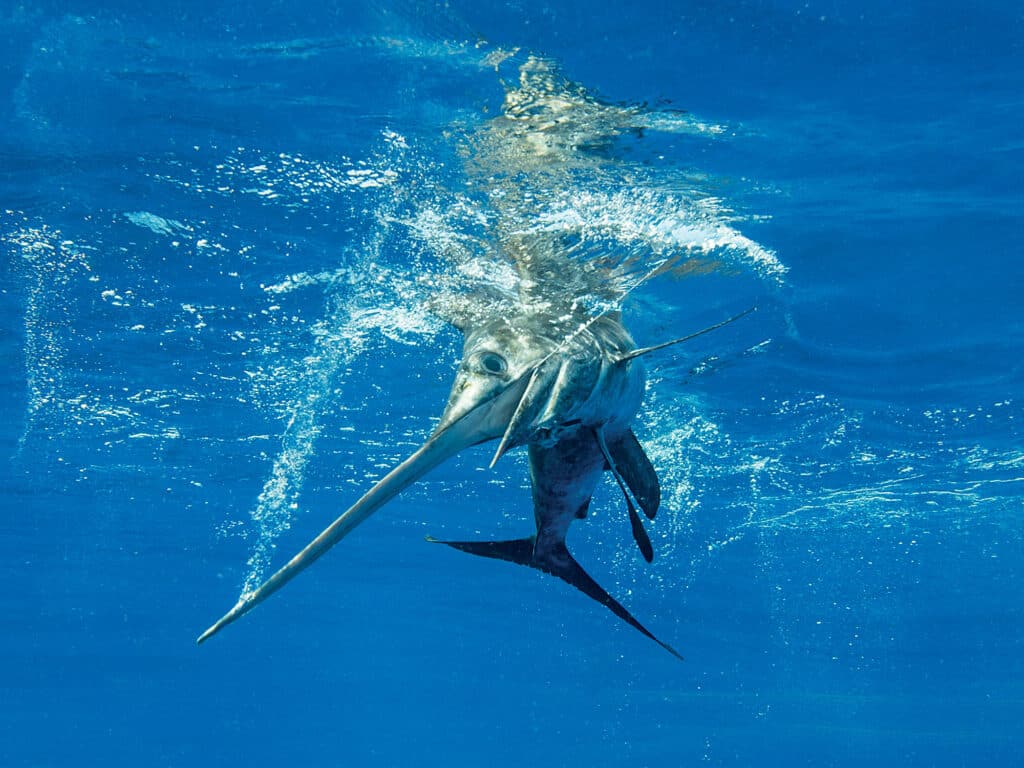
Today, saltwater anglers ply ever-increasing depths to catch fish. California rockfish anglers work structure lying 600 feet below the surface. Alaska fishermen target halibut in 750 feet. Deep-drop enthusiasts seek tilefish at depths of 1,500 feet or more. Daytime swordfish anglers drop baits to 2,500 feet or deeper. Whether fishing the equivalent of two football fields or a half-mile below the ocean surface, each of these fisheries requires highly specialized tackle and sonar transducers with frequencies to penetrate the abyss. Yet there is no one frequency that fits all deepwater fishing scenarios, says Craig Cushman, director of marketing for Airmar Technology Corp., the leading third-party supplier of marine transducers for brands such as Furuno, Garmin, Humminbird, Lowrance, Simrad and Raymarine.
“When an angler asks about transducers for deep water, the first question I ask is, ‘Where are you trying to catch fish?’” Cushman explains. While there are dozens of potential frequencies, it often boils down to a decision between a medium or low frequency.
Frequency Fundamentals
Frequency is the most important factor in deep water. So it’s critical to understand the principles of transducer frequency. Cushman references the sound of a car stereo as an analogy when explaining frequency. “When a car is playing music with the windows up, people outside might hear the bass notes, but not the treble,” Cushman points out. “That’s because bass notes broadcast at lower frequencies, which can better penetrate the car’s thick glass windows.” By the same token, lower-frequency sonar (40 to 60 kHz) can better penetrate the depths. “As the car windows are rolled down, you might pick up treble notes that could not penetrate the glass but now carry elevated octaves,” Cushman adds. Similarly, a higher-frequency sonar (130 to 310 kHz) might not penetrate the depths but can pick up fine details in shallower water.
Medium-frequency sonar (80 to 130 kHz) strikes a compromise between low and high frequencies. It can reach fairly deep and offer benefits not available in lower frequencies.
Question of Depth
Definitions of deep water vary. “While one angler views 1,000 feet as deep, another might define it as 2,500 feet,” Cushman explains. For the first angler, a medium frequency might be a better choice. For example, the medium-frequency, chirp-ready B175M model will read down to 1,500 feet and also provide strong performance at shallower ocean depths.
However, the second angler might be disappointed in the medium frequency. “The B175M might pick up a bottom echo at 2,500 feet, but not much else,” Cushman explains. “On the other hand, the low-frequency, chirp-ready B175L will produce a strong bottom reading and show fish and bait at 2,500 feet.”
Target Separation
When it comes to details, medium frequencies tend to show more than low frequencies, Cushman says. “If you’re looking for grouper or snapper with their chins in the rocks at 800 to 1,000 feet down, the B175M has the performance characteristics to separate these targets from the structure,” he explains.
This is largely because of a narrower beam angle that helps better define details. The B175M has a beam angle ranging from 16 to 11 degrees. The B175L, on the other hand, has a wider beam angle ranging from 32 to 21 degrees, and that does not offer the same kind of target separation.
However, a wide beam offers distinct advantages over a narrow beam, providing a wider search pattern, and that can prove helpful when looking for species such as swordfish that swim well above the bottom. In these cases, target separation is less important than the ability to view a wide swath of the water column, Cushman points out.
Read Next: Using Multi-Purpose Transducers to Find Fish
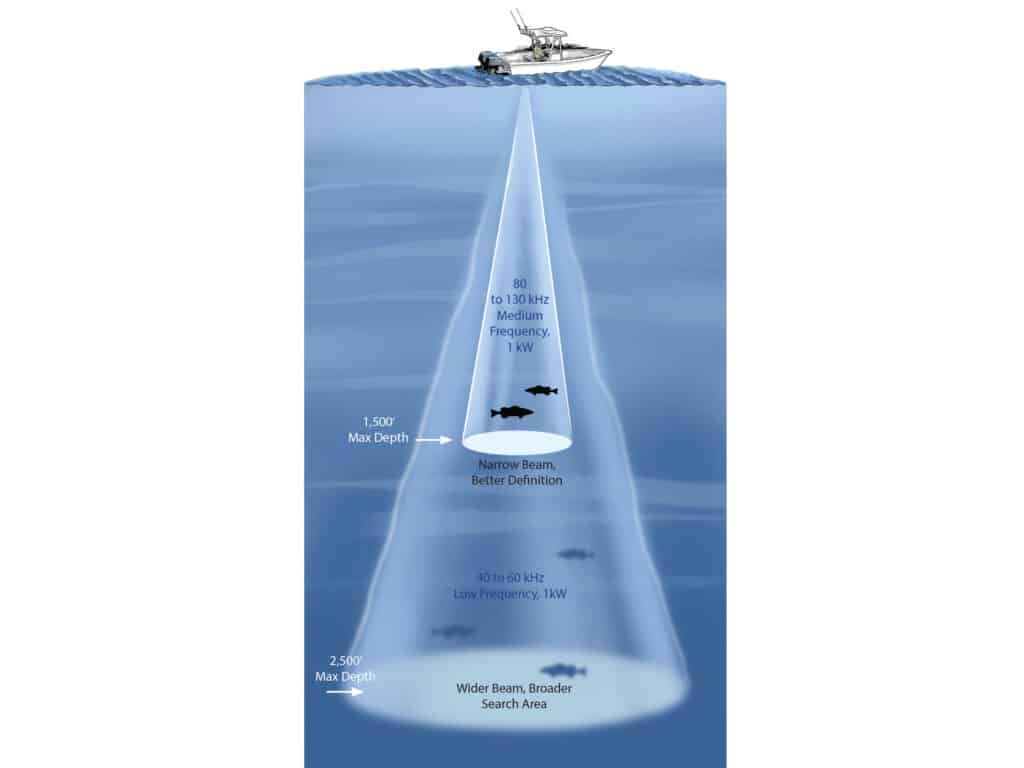
Transmitting power represents the second-most important consideration for deep water. “All things being equal, a 1,000-watt transducer will perform better than a 600-watt transducer,” Cushman says. “It’s like turning the volume up on the car stereo—it will just boom down deeper.”
Of critical importance here is that the fish finder and transducer need to be compatible in terms of power.
Anglers who are serious about deepwater fishing gravitate to even more-powerful systems that pump out 2,000 or even 3,000 watts, Cushman observes. Yet the transducers are big.
“You need a larger, wider transducer to push energy into the water,” Cushman explains. “So, physical size increases proportionately to increases in power.”
For a comparison, Airmar’s popular low-profile, tilted-element B175 series chirp transducers mentioned earlier have faces with 14.5 square inches of surface area and pump out 1,000 watts. But Airmar’s CM599 cavity-mount chirp transducers have faces with 88.8 square inches of surface area that produce 2,000 to 3,000 watts of power.
However, many of today’s saltwater fishing boats are limited when it comes to transducer size. For example, the CM599 transducer measures 14.5 inches long and 6.13 inches wide, and requires a cavity built into the bottom of the hull. Compare that to a 3.75-inch-diameter hole needed for a round B175 series transducer.
On a 30-foot center-console boat, the sheer size, fiberglass work and expense of a CM599 transducer might not be practical or even feasible. Yet just about any saltwater fishing boat built today can accommodate one or even two of the Airmar B175 series transducers.
Ultimately, the depth range, target species, fish-finder capabilities, boat size and budget will help guide selecting the right transducer frequency for you, your boat, your fish finder and your style of deepwater fishing.
- More: April 2023 , Electronics , How-To , Transducers
- More How To
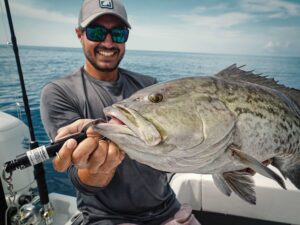
Return ‘Em Right Tips for Safely Releasing Reef and Bottomfish
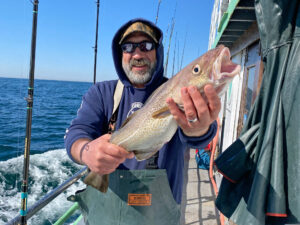
Cod Hotspots
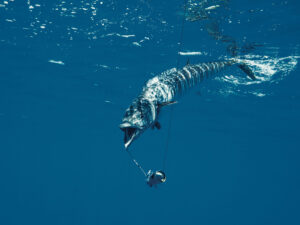
Wahoo Fishing Guide
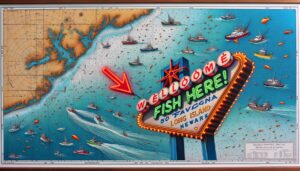
The Numbers Game: Is It Ever OK to Share GPS Coordinates to Offshore Bites?

Explained: Florida’s Polluted Water Problems
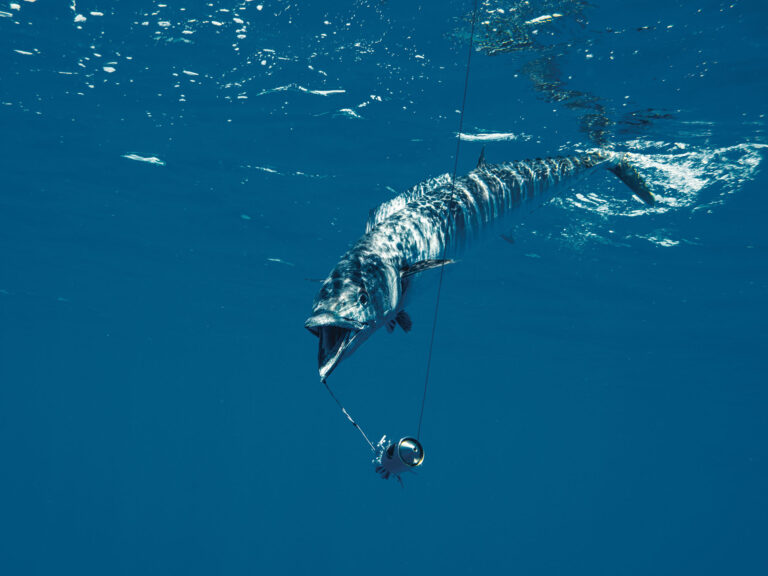
On Fishing With Millennial YouTubers
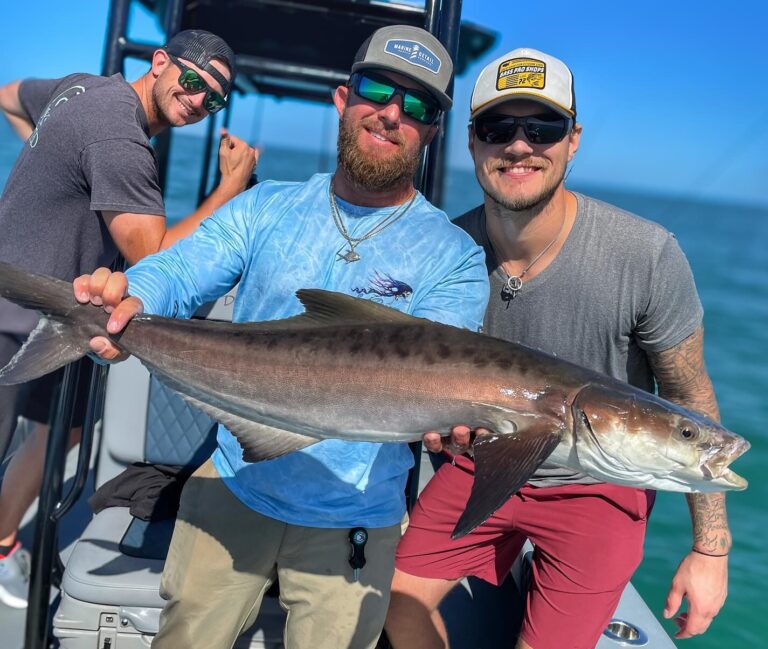
Fort Myers Beach Gets Back to Fishing

- Digital Edition
- Customer Service
- Privacy Policy
- Terms of Use
- Cruising World
- Florida Travel + Life
- Sailing World
- Salt Water Sportsman
- Sport Fishing
- Wakeboarding
Many products featured on this site were editorially chosen. Salt Water Sportsman may receive financial compensation for products purchased through this site.
Copyright © 2024 Salt Water Sportsman. A Bonnier LLC Company . All rights reserved. Reproduction in whole or in part without permission is prohibited.

IMAGES
VIDEO
COMMENTS
6. Garmin Echo 551dv Worldwide with Transducer. This is an excellent depth finder that can also work as a basic fish finder. With a power peak of 4,000 watts, this device can easily offer accurate readings up to 2,300 feet, which is pretty outstanding.
where would the best place to install a transducer be on a mac venture 17 swing keel . D. dlochner. Jan 11, 2014 11,243 Sabre 362 113 Fair Haven, NY Dec 29, 2019 #2 What kind of transducer? ... Not wanting to pay to have the boat forklifted in and out of the water I tried plumber's putty. Little by little I was able to reduce the flow.
Flush thru-hull transducers sit flush or nearly flush with the boat hull. These are recommended for smaller boats with a minimum deadrise angle. They are often installed on sailing vessels because they produce minimum drag. External thru-hull transducers extend beyond the hull's surface and usually require a fairing to aim the sound beam ...
Transducer Frequency. The accuracy with which your fishfinder detects bottom and other objects is also determined by the frequency selected for the depth you are viewing. Raymarine depth transducers can be tuned to two different frequencies: 200 kHz (high) or 50kHz (low). 200 kHz works best in water under 200 feet/60 meters and when you need to ...
Most challenging to install, but likely to provide best signal quality. Displacement, power and sailboats generally use thru-hulls. If you are considering installing a thru-hull on your boat, check out our West Advisor article on Installing a Thru-hull Transducer. Tilted Element Transducers. A type of semi-flush thru-hull transducer.
A narrow beam of 10-15°, on the other hand, concentrates its energy on a section right below the boat. When looking for individual fish or bottom structure in shallow water (say under 100-200'), a narrow-beamed transducer should be the first choice. Note that there is a certain amount of correlation between a transducer's frequency and its ...
Airmar suggested mounting two transducers: The B-275-LHW (low-high-wide), which will provide a high-wide "searchlight" - ideal for locating striped bass in open water, or pelagic fish like tuna cruising down to 500 feet - and low frequency for deeper penetration. To keep the face of the transducer out of the boundary layer of bubbles ...
This allows the transducer to operate properly, even while the boat is running at high speed. In fact, the boat cited in the opening paragraph is a step-hull model — the new Mag Bay Yachts 33 — with an Airmar B164 through-hull, low-profile transducer for conventional 50/200 kHz sonar installed just forward of the front step. LED DILEMMA
1. Transom-mount transducers - Transom-mount transducers are the most common type, especially on smaller boats that are about 25 feet long and shorter. They offer good detail, but installing one can be a bit tricky because a transom-mount transducer needs a solid flow of water with as little turbulence as possible.
Installing the transducer: For through-hull installation, carefully drill a hole in the boat's hull at the chosen location, following the manufacturer's guidelines. Apply sealant around the hole and insert the transducer, ensuring a watertight seal. Connect the transducer cables to the depth finder unit, routing them through appropriate ...
The Garmin striker 4 transducer is not only one of the best depth finder for sailboats, but it also works as a fish finder. Apart from that, this device even offers the option of omitting a transducer because of the built-in HD-ID sonar. Display . The device can take readings up to 2300 feet due to its 4000 watt power.
Through-hull transducers are mounted through a hole drilled in the bottom of the boat and protrude directly into the water. This type of transducer generally provides the best all-around performance. Through-hulls are recommended for displacement hulls and boats with straight-shaft inboard engines. You'll also need a fairing block that allows ...
After narrowing down the type of transducer that makes the most sense for your boat, you still face several options. "When a customer asks me which transducer is best, the answer is always the same: It depends," says Peter Braffitt, general manager of Gemeco, the distributor for Airmar, the world's leading manufacturer of marine transducers.
Active Imaging 3-in-1 Transducer. Active Imaging delivers images of fish and structure with more refined detail and at a longer range than any other structure imaging technology. $329. Find a dealer. Browse all sonar products. With more options than you can shake a rod at, choosing this essential piece of equipment can be confusing.
Transducer placement is extremely important to mark fish at speed. Transducer placement and mounting is the most critical step to sonar performance, but is ...
The LUCKY depth finder comes as a wired depth finder with a digital handheld unit that connects via a 7.4 m cable to its 200 kHz 45° wide-angle transducer. It measures up to 100m depths, comes with a fish alarm, and displays profiles and locations of fish, plants, and debris.
The money you spend on the transducer is the best you can spend on a fishfinder, according to Hillers. "If I buy a $3,000 echo-sounder and a $70 'ducer, I've wasted my money. I'd rather have a $1,000 transducer with a $2,000 sounder and get a much better system."
A 50 kHz Transducer may have a 35° Beam angle, whereas dual- frequency or dual search transducers come with both narrow (eg. 12°, 200 kHz) and wide (eg. 35°, 50 kHz) Beam angles. Typically a lower Frequency will give you a wider Beam angle. While a wider angle may give you a wider view of what's beneath your Boat, the Resolution won't be as ...
An in-hull (aka shoot-through) transducer mounts to the inside of the hull and transmits and receives sonar signals through fiberglass, eliminating the need for drilling holes in the hull. This also eliminates the need to remove the boat from the water for installation, and there will be no protrusions under the boat. But there are downsides.
Where to mount a transducer on a boat. The top five transducer mounting locations on a boat are: Transom mount. Trolling motor mount. In-hull mount. Pole mount. Thru hull mount. Out of these five transducer placement options, the most commonly used ones by far are transom and trolling motor mounts, though the other three can also be great ...
3. Garmin Transom/Trolling Motor Mount Dual Beam Transducer. If you're searching for a transducer that can provide both depth and temperature information without draining your pockets, then the Garmin Dual Beam Transducer is the perfect match. Garmin 200-kHz and 50-kHz Transom Mount Transducer Kit-15-Degree Beamwidth.
However, many of today's saltwater fishing boats are limited when it comes to transducer size. For example, the CM599 transducer measures 14.5 inches long and 6.13 inches wide, and requires a cavity built into the bottom of the hull. Compare that to a 3.75-inch-diameter hole needed for a round B175 series transducer.